
SPRING 2023 UDENT
CUL I A T A K E S CHARG
NHISTO R Y M U MUES
S SAVE
WINNE R S THE
ON
The Law of the Sea
Embroidery by Abby Mangerson ’26
ARTIST STATEMENT:
The Law of the Sea was passed by the U.N. to address overfishing and the claim of territory into the oceans by countries. I used different stitches and colors to signify different aspects of my image. The boat on the left side of the artwork is fading out, as the fish in the water fade in. I used white, gray, and black threads to show this transformation. I kept the coral reef colorful using run and split stitches. I wanted this to represent how even though climate change is causing the oceans to become more acidic, killing the coral reefs, overfishing will kill them faster, removing key aspects of the ecosystem, the fish. Overall, I want this project to bring together the ocean and land ecosystems. By overfishing, we are not only impacting the ocean ecosystems and the global economy, but also the villages, towns, and cities on our coasts that depend on fishing for a living.
See more Art & Social Change embroideries on page 7.
LOWER SCHOOL
50 Prospect Park West Brooklyn, NY 11215
MIDDLE AND UPPER SCHOOLS
1 Poly Prep Drive Brooklyn, NY 11228
OFFICERS
Andrew Foote P’27, ’29
Chair
Michael A. Correra ’87
Vice Chair
Kareem Raymond P’31, ’33 Treasurer
Jennifer Powers P’26, ’28 Secretary
TRUSTEES
Indhira Arrington P’29, ’31
John P. Foley P’26
Nicholas Gravante, Esq. ’78, P’20, ’23
Hans Humes P’12, ’15, ’21, ’35
Thomas Iannelli ’82, P’18, ’19, ’24
Taek-Geun Kwon P’32
Sang Lee P’22, ’23
Michael Liburd P’21
John D. McPheters P’33
Cassandra Metz
Laurie Rosenblatt P’23, ’26

Elizabeth R. Schlesinger P’28, ’30, ’32
Irwin Simon P’18, ’22
Daniela Vitale-Howell P’20, ’23, ’25
Elizabeth R. Wiatt
Maxwell T. Wiley P’18, ’21
BOARD MEMBER, NON-TRUSTEE
Qadir Forbes ’11 (Pres. Alumni Board of Governors)
TRUSTEES EMERITI
Dr. Karen Burke Goulandris P’15 Harry J. Petchesky, Esq. ’55
THE COVER:
7
FEATURES
4 LUCIA TAKES CHARGE
Lucia Zaremba ’25 works with NY State Senator Andrew Gounardes on life-saving EpiPen legislation.

8
CAN POLY STUDENTS SAVE THE PLANET?
Conservation Biology students negotiate from the perspective of five interest groups to keep the globe from warming more than +2 degrees Celsius.
16 THEY MADE A DEAL
Holden Pawlak ’24 and Anjali Budhram ’24 win Poly’s Shark Tank with innovative apps.
18
THE GREAT AFRICAN HISTORY MUSEUM
A visual tour of Grade Four’s Great African History Museum is inspired by the art and culture of 10 African civilizations that helped shape the modern world.

DEPARTMENTS
26 CLASS NOTES
28 OBITUARIES
EDITOR-IN-CHIEF
Jennifer Slomack
STAFF WRITER
Linda Busetti
COPY EDITOR
Linda Busetti
DESIGN
Joseph Inglis
PHOTOGRAPHY
Linda Busetti
THE BLUE & THE GRAY is published by Poly’s Engagement & Communications Office. It features news from the Poly community of alumni, faculty, and students. Inquiries and submissions are welcome. Contact communications@polyprep.org.
For more information about Poly Prep, visit polyprep.org.

POLY PREP MAGAZINE SPRING 2023
4 8 18 1 POLY PREP COUNTRY DAY SCHOOL SPRING 2023
CONFIDENCE. PERSISTENCE. RESILIENCE.
Children grow in wonderful and surprising ways when the Arts are a meaningful part of their education. They discover their voice. Develop self-confidence. And through meaningful engagement with the artistic process, learn to persist, collaborate, and problem solve. We witness this lifelong influence of the Arts every day at Poly Prep, and it’s why we’re committed to doing more to ensure our students have the space and resources needed to fully pursue their passions and talents. Play your part and support the new Poly Arts Center. polyprep.org/artscenter
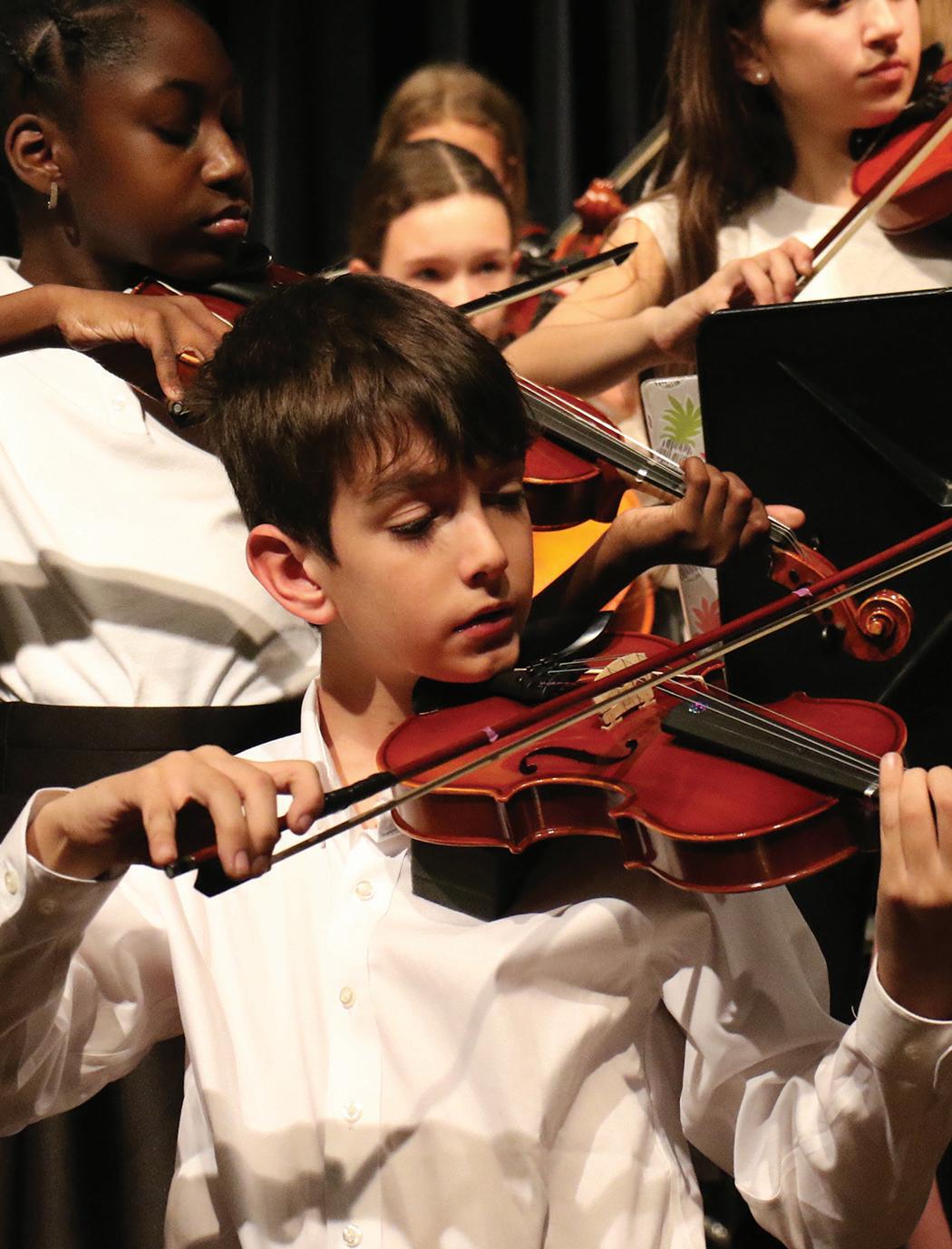
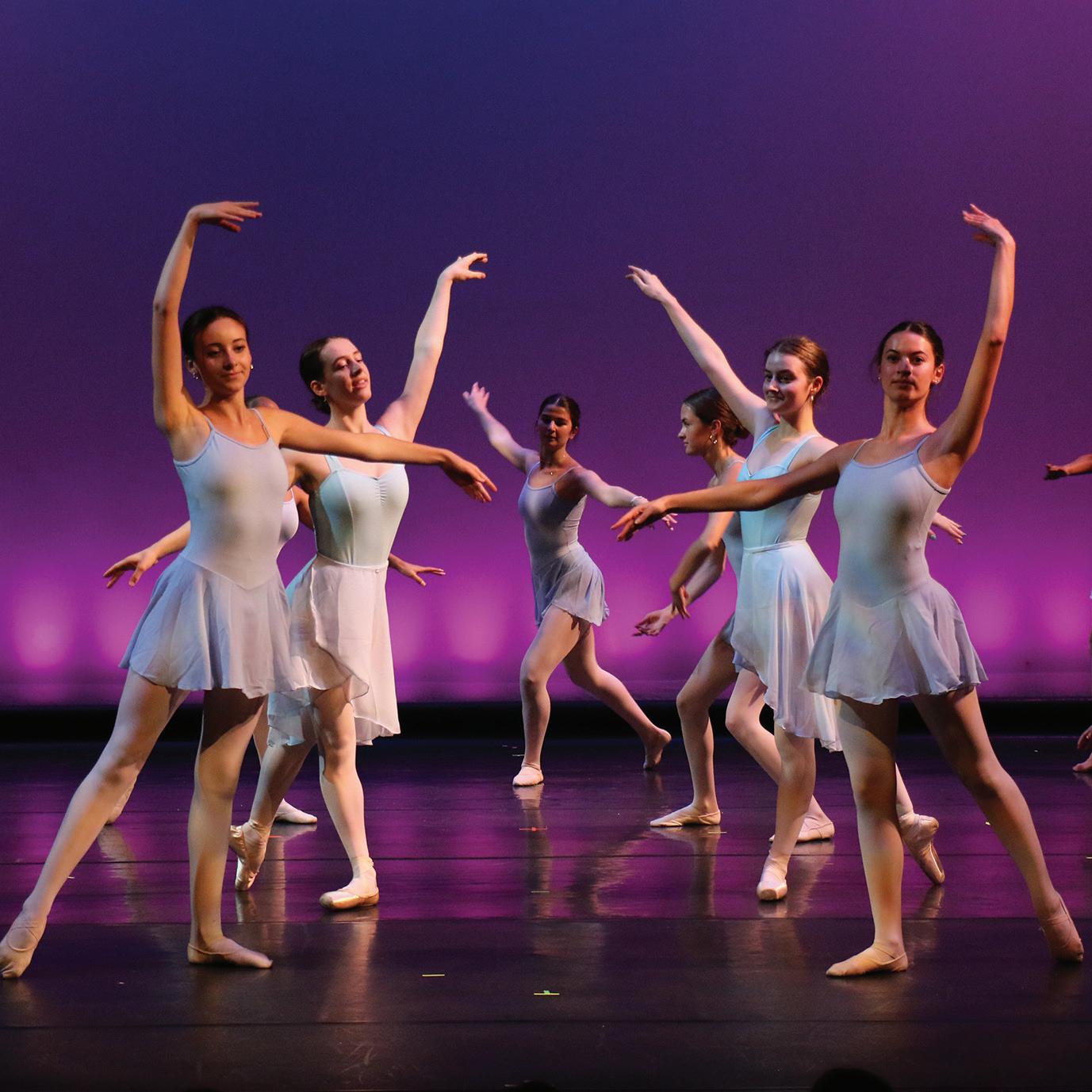
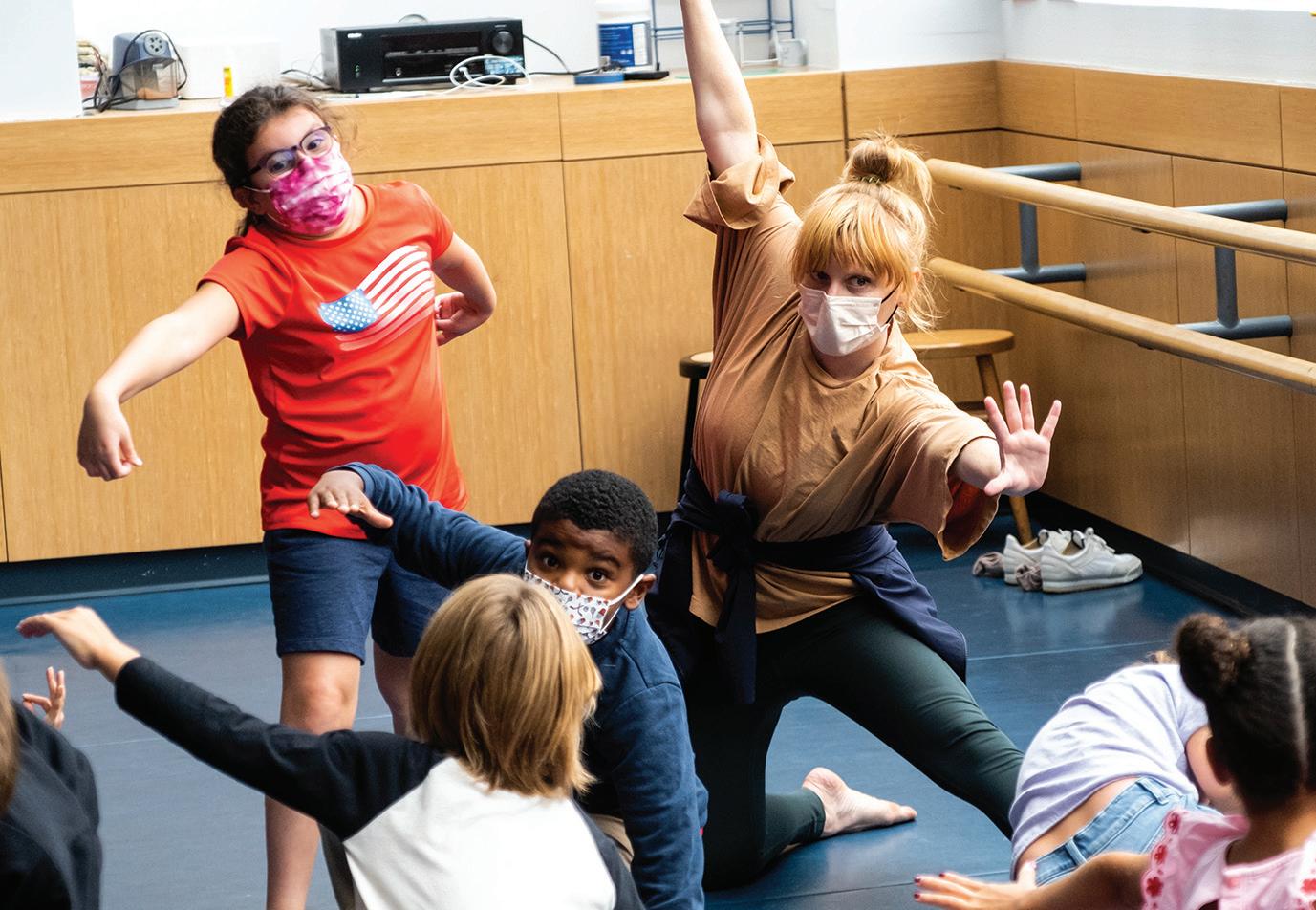
DEAR POLY COMMUNITY,
We live in an ever-changing world. On February 5, 2008, one of the deadliest tornado outbreaks in our nation’s history tore across the southern United States and lower Ohio Valley. It was a tragic wake-up call about the potentially devastating effects of climate change. That same night, the junior senator from Illinois, Barack Obama, had a triumphant day at the Super Tuesday polls. A transcendent orator (and writer), he spoke before a large crowd in California: “Change will not come if we wait for some other person or some other time. We are the ones we’ve been waiting for. We are the change that we seek.”
Change is inevitable–the biggest difference lies in whether we wait for it to affect us, or lead it. Leaders know that making change requires effort, action, and the willingness to take risks and try new things. Whether it’s a small step or a big one, every effort counts. In this issue of The Blue & The Gray, we look at some of the leaders and changemakers in our community. I am proud of our students, and the faculty who guide them, as we consider how we can impact the world around us today or prepare our students to do so in the future.
Witnessing her brother, John Zaremba ’29 , have a life-threatening allergic reaction, was the impetus for Lucia Zaremba ’25 to reach out to State Senator Andrew Gounardes. Lucia had learned (the hard way!) that large public places like stadiums are not required to have life-saving EpiPens available, the way AEDs are posted. Senator Gounardes responded to Lucia’s efforts and together they have introduced legislation that is pending in the New York State Senate.
We hear much about climate change, but what will it really take for countries and special interests to make the changes necessary to avoid a global warming catastrophe? In Dr. Ramesh Laungani’s Upper School Conservation Biology class, students were divided into five interest groups and over the course of a three-day Mock Global Climate Change Conference had to negotiate with each other to make changes such as taxing coal or investing in new clean technology that would limit the rise in global temperature to 2.0 degrees Celsius. Their story of the lessons of compromise makes for fascinating reading.
At the Lower School, Aiyana Parker’s monthlong unit on African History culminated in Grade 4’s Great African History Museum tours. During this exclusive visit, the student creators shared with visitors how ancient African nations influenced art, science, politics, and economics throughout the world. You’ll be inspired reading about Aiyana’s leadership and be sure to visit the news section of our website for a video tour.
Finally, on our Dyker Heights campus, your support and leadership have led to visible change as steel beams rise to form the skeleton of our new Arts Center. You can feel the energy among our student actors, musicians, dancers, and artists as they imagine the incredible difference this state-of-the-art structure will make on their ability to rehearse and create. Thank you for your continued support and I look forward to our continued work together to lead positive change at Poly.
Sincerely,
Audrius Barzdukas P’20 Head of School

MESSAGE FROM THE HEAD OF SCHOOL
3 POLY PREP COUNTRY DAY SCHOOL SPRING 2023
LUCIA TAKES CHARGE
While most kids would think nothing of getting a hot dog at a baseball game at Yankee Stadium, for John Zaremba ’29 , the choice is not so easy. Lucia Zaremba ’25 recalls walking around the stadium with her brother and cousin last year and checking with vendors to see which foods would be safe—nut-free and not cross-contaminated—for her brother to eat. Only one vendor would weakly assure her that their food was safe. Would there be an EpiPen available if John had a bad reaction to the food?
EpiPen is the brand name of an auto-injectable device that delivers the drug epinephrine, a life-saving medication used when someone is experiencing a severe allergic reaction, known as anaphylaxis, an allergy emergency that can cause death in less than 15 minutes.
The reason Lucia Zaremba was so concerned was because at the age of nine she had witnessed her younger brother, then five, have a life-threatening allergic reaction. After being bitten by a tick, John, who already had severe nut allergies, developed
alpha-gal syndrome and an allergy to red meat. As a result, John had a severe and potentially lethal reaction to eating a piece of steak. The quick actions of his mother, Nancy Zaremba P’24, ’25, ’29 , using an EpiPen, saved John.
“John’s food allergies have changed our family’s daily living,” said Nancy Zaremba. She explained, “John is allergic to peanuts, tree nuts, sesame seeds, and legumes. Nuts and sesame seeds are the tricky ingredients for John when scouting out foods like hot dogs at Yankee Stadium. You wouldn’t believe how many bread products have sesame seeds in their ingredients and nut cross contamination.”
“Everything we do is in the interest of keeping John safe,” Nancy Zaremba said. “We can only eat or order out from certain restaurants and even that is not so simple. We have to read food labels on everything we buy in the grocery store. Something as simple as going to the movie theater or a birthday party can be challenging for John. It’s difficult some days because he just wants to be ‘normal’ and not have to worry about what he is eating. Ever since he had
4 THE BLUE & THE GRAY
Lucia Zaremba ’25 teams up with State Senator Andrew Gounardes on legislation to require life-saving EpiPens in public venues.
an anaphylactic reaction to something we didn’t know he was allergic to, we continue to be thankful that we had an EpiPen on hand, but also know that not everyone is in the same boat.”
The terrifying emergency traumatized the Zaremba family, Lucia said. Her mom taught her how to use an EpiPen in case of another emergency. To Lucia, it seemed like common sense that there should be EpiPens located in all large public venues the way we see AED (Automated External Defibrillator) boxes posted. That is why when she had the opportunity to speak with State Senator Andrew Gounardes (D) 22nd District about the issue, she could see a way to get something done. Lucia has been working with Senator Gounardes on ideas for legislation to be proposed when the new New York State Senate session began in January. Lucia says the bill would cover large public venues such as schools, shopping centers, stadiums, and restaurants. Such a law, when enacted, “would save people’s lives,” she said.

5 SPRING 2023
Lucia Zaremba ’25, NY State Senator Andrew Gounardes, and John Zaremba ’29
“When Lucia told me her family’s story,” Senator Gounardes said, “I was heartbroken to hear of the fear she, her brother, and her parents had all experienced when her brother’s anaphylactic reactions had occurred. And the solution she proposed—ensuring EpiPens are accessible to New Yorkers across the state in public venues—made absolute sense to me. After our conversation, I began the process of writing this bill.”
“The legislative process is a collaborative one,” Senator Gounardes continued, “where I’ll work with my colleagues to help them understand the need for this bill to become law. I know many legislators— and families—across the state already have a deep knowledge of the dangers of anaphylaxis, and I am confident that my colleagues and I can work to get this life-saving bill passed.”
Senator Gounardes introduced legislation, Senate Bill S1078 in January in the new legislative session of the New York State Senate. The proposed legislation “requires places of public assembly to maintain epinephrine auto-injector devices and to have at least one employee who is trained in its use.” As of late January, the bill was in committee and could be passed by June 2023.
Lucia said she hopes that the proposed legislation will get more recognition and support. News media is a big part of it, she said. That is why she is happy to do interviews to spread the word. She may even go to Albany at some point to speak in support of the bill.
“I think it’s really cool that my sister, Lucia, is doing this to help kids like me with allergies,” John Zaremba said. “When Lucia told me she was reaching out to
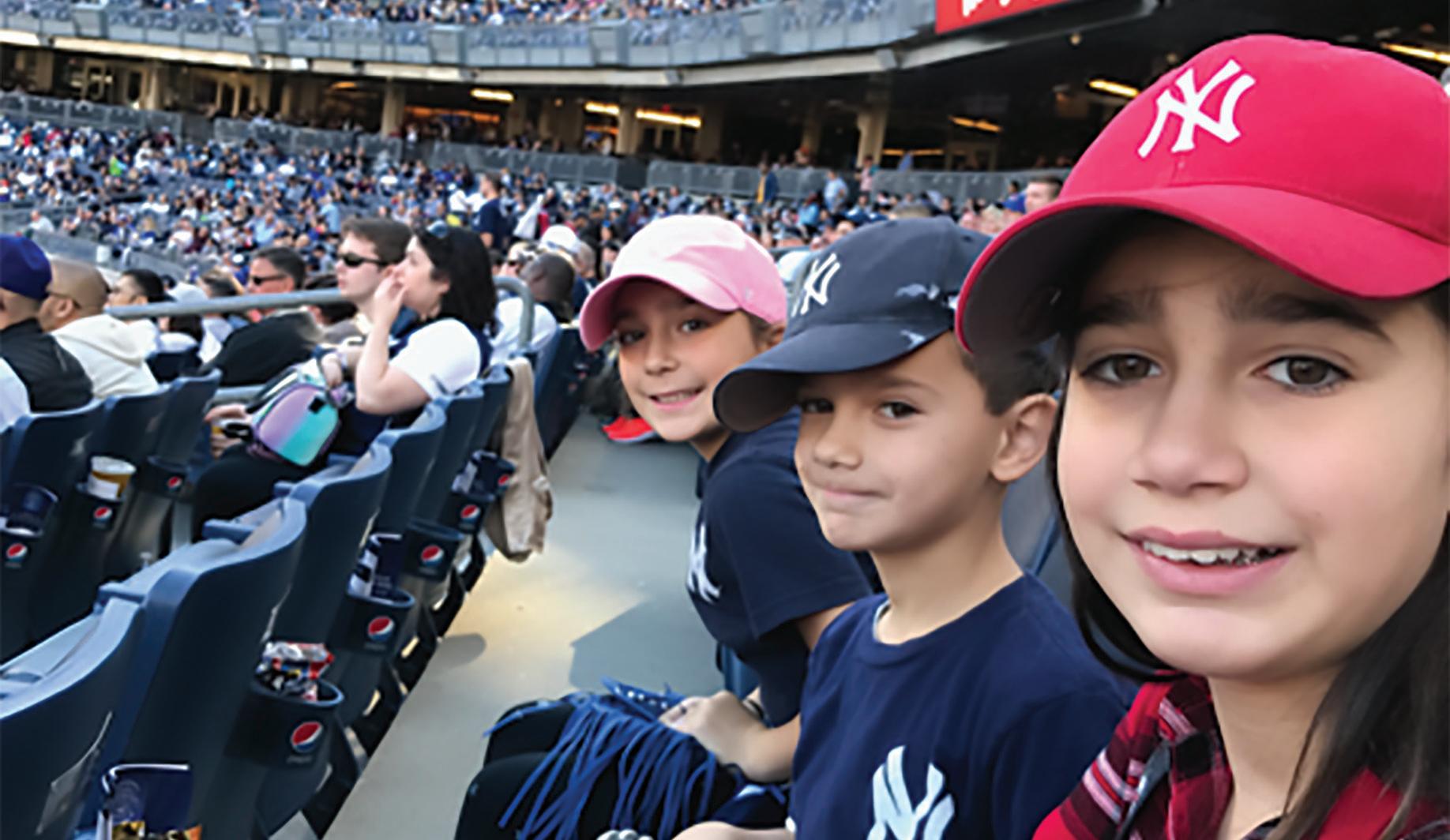
Senator Gounardes to change the law, I couldn’t believe it. I think it’s a great idea, and it’s really great that the Senator is interested in helping people with allergies.” He added, “I wish everyone knew how scary it is to have life-threatening allergies. I may not show it, but I’m always afraid every time I have a meal I could have a life-threatening allergic reaction, even going to an arena, I’m scared of what I can eat and what I can’t eat.”
John continues to bring an EpiPen to school. Poly Nurse Sara Siller said, “For the most part, our students carry their EpiPens, but I do also keep student EpiPens here in my office. I also have a stock supply in case needed. There are no central locations on campus to access EpiPens aside from my office and the trainers office down the hall. I love the idea of having EpiPens in designated areas around campus—especially since the nurse’s office is far from the students.”
Lucia, a tenth grader who is on the staff of The Polygon and enjoys public speaking, says the experience of working with Senator Gounardes has been inspiring.
“Our entire family is beyond proud of Lucia,” Nancy Zaremba said. “We are so proud of Lucia for wanting to make a change for not only her brother, but for everyone in New York, especially those who are not aware of their allergies. Stocking EpiPens in all places of public assembly along with someone who knows how to use it is life changing. She has taken a terrible moment in her life and is trying to turn it into something positive. She is a really good sister and we couldn’t be prouder as her parents.”
6 THE BLUE & THE GRAY
Mia Zaremba ’24, Lucia Zaremba ’25, and John Zaremba ’29 enjoying one of many games at Yankee Stadium over the years.
My work is intended to convey how climate change has evolved through time. The images express the damages and causes of climate change. It contends with the issues of factories, labor, and global warming.

Art is a powerful changemaker. It can evoke strong emotions, challenge beliefs, inspire action, and create connections. Students in the Upper School Art and Social Change course were asked to research an issue that the United Nations identified as a global concern and then, in the tradition of social activists and protest art, represent it through embroidered imagery and text. These students’ artworks express their personal preoccupations with the global issues of climate change, from ocean pollution to deforestation, and migration and seek to tackle the conflicts and stories behind them.
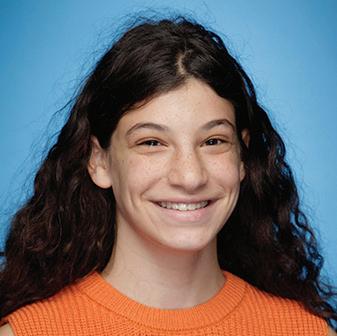
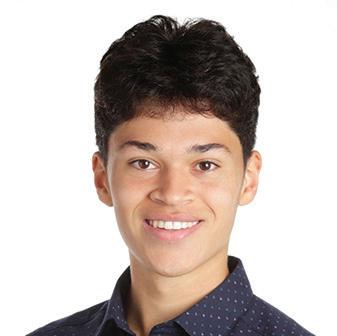


My piece contains the shoes of diverse cultures in a spiral pattern, showing the continuous walking that migrants face. On the sides of my embroidery, I wrote “opportunities” and “escape,” which are both reasons for migration. In the center of my piece, I wrote, “We are all migrants.” Although we may not be migrating for escape and opportunity, as New Yorkers, we are always walking and commuting. Many of us are also of migrant or immigrant descent, and I wanted to include this relatable element in my piece.
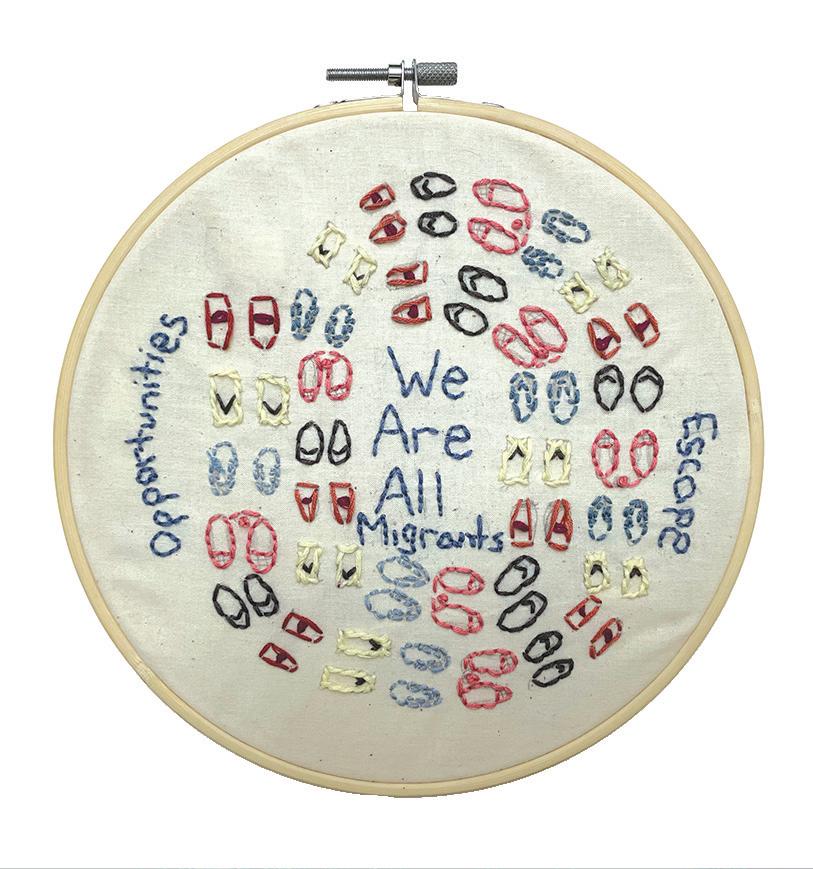
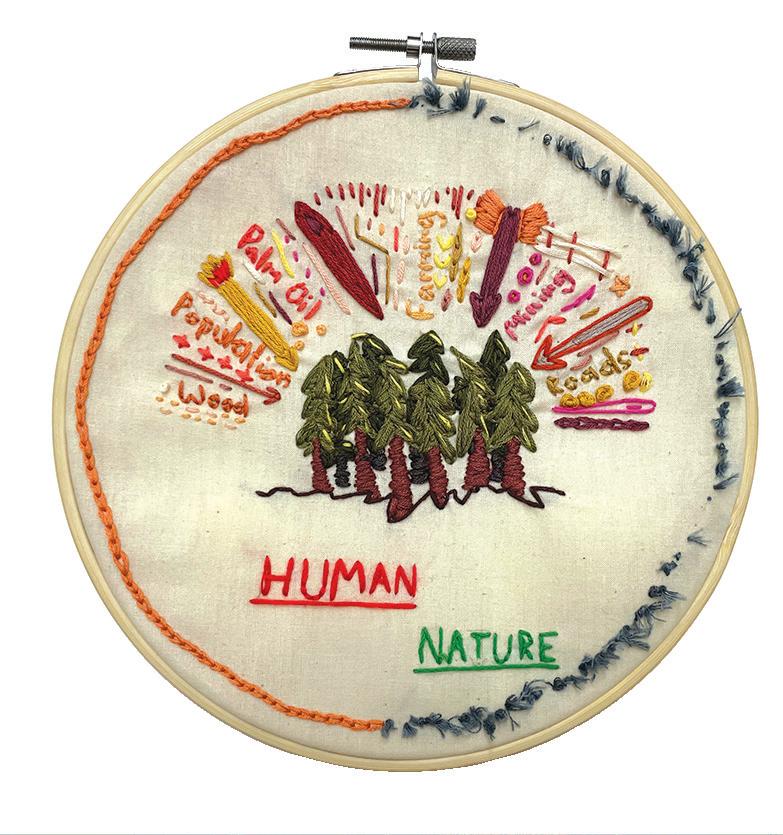
This piece addresses deforestation. In the center lie evergreen trees with yellow accents to demonstrate bright light shining on them. Surrounding the trees in an arch lies different abstract shapes, arrows, needles, and weapons with a sharp design all facing toward the trees in an aggressive manner. Some of the main causes of deforestation are written on the arch to symbolize the harm that they do to the trees. Below the patch of forest are the words “Human Nature.’’ The phrase has a dual meaning. One interpretation could be that “Human Nature’’ means human tendencies are causing the loss of natural environments. It also could be viewed as Humanity vs. Nature, which is represented by the opposing green and red of the words. The border of the loom is a stem stitch on one side and frayed string on the other to symbolize the “before and after” of our forests. The border stitching are complementary colors just like the words “Human Nature” to add to the contrast of the piece. Overall, this artwork is to inform people about the causes of deforestation through the words in the arch so that people are enabled to stop their indirect harm to the environment (i.e., cutting down the use of palm oil). The piece also gives the viewer vivid imagery portraying how we as a human population are harming the environment that we so desperately need to survive.
 Eden Golomb ’26
Nate Hyman ’26
Sebastian de Luque ’23
Eden Golomb ’26
Nate Hyman ’26
Sebastian de Luque ’23
7 POLY PREP COUNTRY DAY SCHOOL SPRING 2023
CANPOLY STUDENTS
 Simone Yoskowitz ’25
Embroidery from Art & Social Change
Simone Yoskowitz ’25
Embroidery from Art & Social Change
SAVETHE PLANET? 8 THE BLUE & THE GRAY
more than +2 degrees C.
The future of the planet is in good hands—in a Mock Global Climate Change Conference at Poly, students representing five interest groups used their negotiating skills to make deals to lower rising global temperatures. But, in the process, they learned that finding solutions to human-driven climate change is complicated. Achieving compromise among interest groups or countries is contentious. It’s not enough to just say plant more trees or tax coal.
The three-day conference in mid January was both a challenging and intense exercise in Dr. Ramesh Laungani’s Conservation Biology class of Grades 11 and 12 students.
Dr. Laungani introduced them to the interactive En-ROADS simulator (developed out of MIT and Climate Interactive) that shows how changes to energy supply, transport, or land-use and industry carbon emissions (among
other things) could slow the rise in global temperature by the year 2100.
Dr. Laungani explained, “The students had some time prior to the start of the conference where they got to ‘play around’ with the simulation tool. In addition, many of the solutions had been discussed earlier in the semester during class, but not in the context of the En-ROADS simulator specifically.”

From the perspective of five interest groups, students negotiate to keep the globe from warming
9 POLY PREP COUNTRY DAY SCHOOL SPRING 2023
Student teams suggested changes for Dr. Laungani to make on this interactive En-ROADS simulator.
THE INTEREST GROUPS

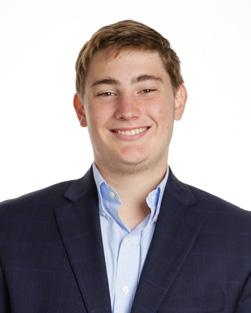


In three class meetings, students worked relentlessly to promote vital global policy changes. The goal of the conference was to “keep the world from 2 degrees of warming, if not less.” Dr. Solvercan warned, “If we do nothing, the earth is projected to warm 3.6 degrees [Celsius].” Would Poly students succeed in doing what Dr. Laungani’s college students had not?

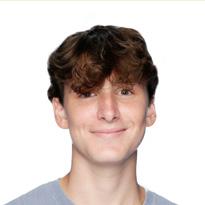
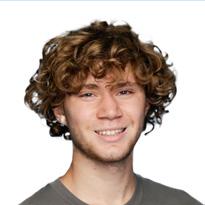


“The first day of the conference the students were working within their own groups to develop their ideal scenario given their priorities,” explained Dr. Laungani. “This ‘within group’ day allowed them to dig into the details of the En-ROADS simulation ‘sliders’ to see which policies they would need to put in place to achieve their group’s specific goals and priorities.”
“Our team had to do enough research to be able to explain each of our proposals,” said Tesvara Jiang ’23 “Without adequate reasoning for our actions, it would be easy for another group to counter and reverse our actions.”


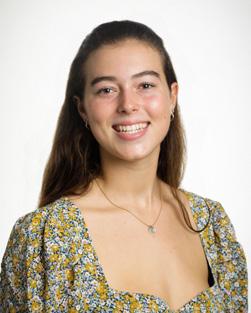
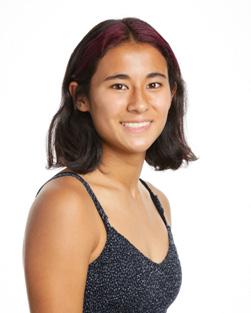

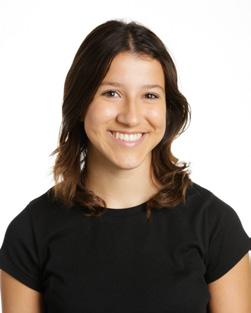

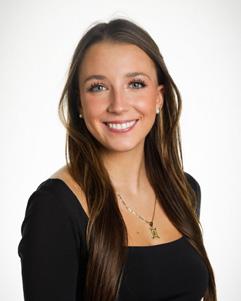

 3K
3
T 3A sher C ohen ’24 Adele ’23
Abb 3
Ty 3
Rohan Unis ’24
Pe ’23
Nicole Bogdanos ’23
Bennett McK ’23
Jack Levin ’24
Marie Culmine 3 Hayden Lewis 3
CLEAN TECHNOL OG Y INDUSTR Y AND COMMERCE
CLIMA TE JUSTICE HA WKS
CONVENTIONAL ENERG Y LAND , A GRICULTURE AND FORESTR Y
3K
3
T 3A sher C ohen ’24 Adele ’23
Abb 3
Ty 3
Rohan Unis ’24
Pe ’23
Nicole Bogdanos ’23
Bennett McK ’23
Jack Levin ’24
Marie Culmine 3 Hayden Lewis 3
CLEAN TECHNOL OG Y INDUSTR Y AND COMMERCE
CLIMA TE JUSTICE HA WKS
CONVENTIONAL ENERG Y LAND , A GRICULTURE AND FORESTR Y
10 THE BLUE & THE GRAY
In the persona of UN Secretary General Dr. Climateson Solvercan, Dr. Laungani led the conference.
ARGUMENTS & NEGOTIATIONS
In public “arguments,” the interest groups brought to the floor proposed policies from their respective vantage points. The participants quickly learned that to accomplish their groups’ goals, they would have to compromise. It was time for deal making.
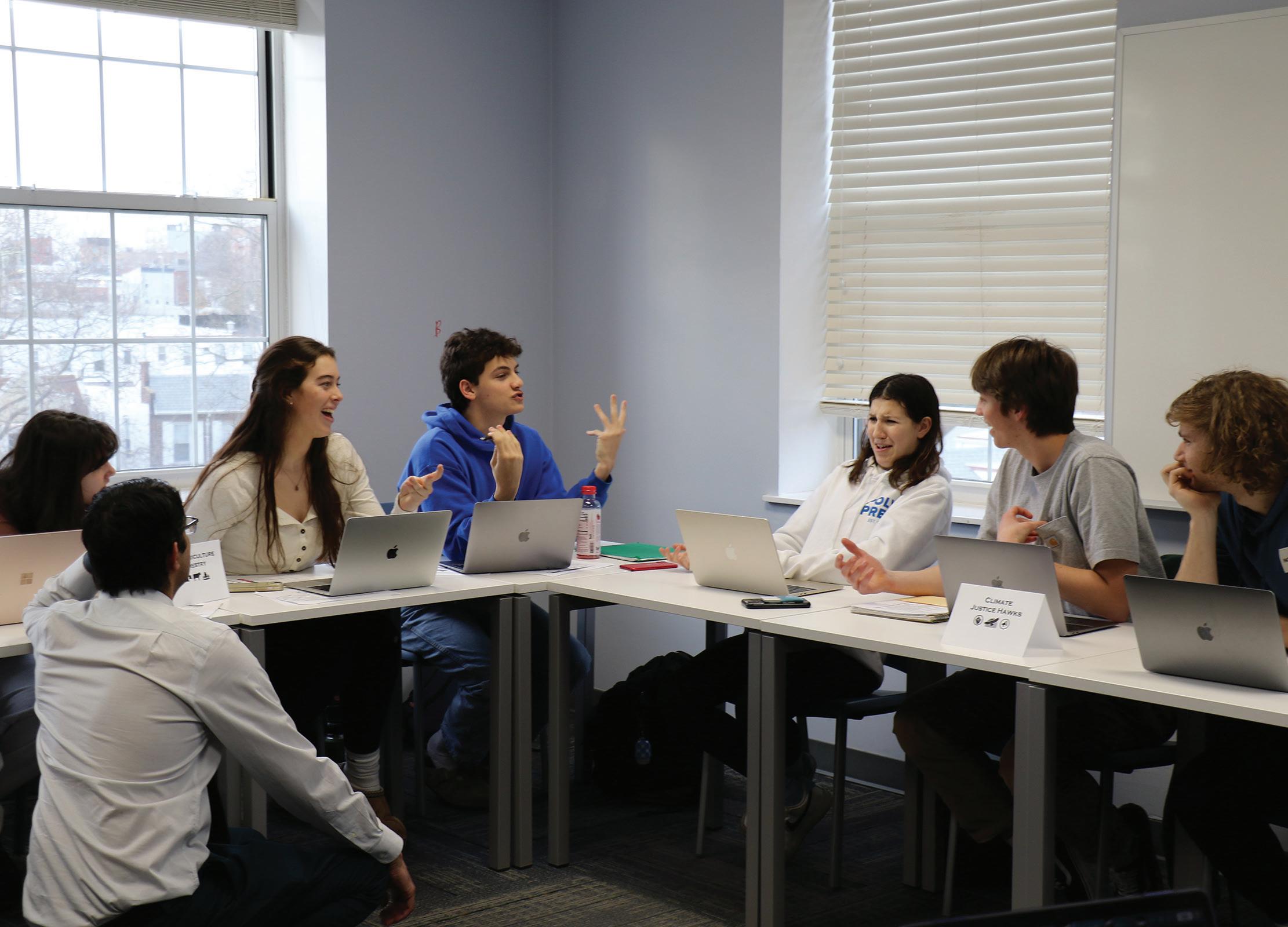
In round after round of impassioned negotiations, groups took turns making carefully considered policy proposals. The fate of the planet was in the balance. Dr. Solvercan would move the sliders in the simulator at their suggestion in an effort to lower global temperature. By the end of the third day, all students would have to agree to and sign a global agreement, their own version of the Paris Climate Agreement.
Opening the first round, Alida Lissak ’23 of Industry and Commerce boldly suggested, “Move technological carbon removal up all the way because right now there is a lot of carbon in the atmosphere and that is doing a lot of damage.”
As a result of moving the slider to its maximum, “We have already knocked off 0.4 degrees C of change,” Dr. Solvercan reported excitedly. “What move would you like to make?” he asked, turning to the Clean Technology team.
“We would like to highly tax coal,” said Jiang resolutely.
“Can you help me understand why you made this move?” Dr. Solvercan probed. Clean Tech’s reasoning was to encourage investment in clean technology.
Climate Justice Hawks were supportive, adding on that renewables would decrease the cost of energy and reduce air pollution “down by five megatons and create less of a demand for coal.”
With a break in the arguments came time for earnest side meetings in which deals could take place. Land, Agriculture, and Forestry and the Climate Justice Hawks discussed how the proposed policy changes would affect the lives of farmers. Meanwhile, the Climate Justice Hawks and Conventional Energy espoused their views on renewables.
Dr. Solvercan noted in an aside, “I did not invite political leaders” to the conference explaining that it is “important to keep apolitical.”
11 POLY PREP COUNTRY DAY SCHOOL SPRING 2023
The Land, Agriculture, and Forestry team negotiates with the Climate Justice Hawks as Dr. Laungani moderates.
The Land, Agriculture, and Forestry team asked to “move afforestation to medium growth.” (Afforestation is the establishment of a forest or stand of trees in an area where there was no previous tree cover.) “As other sliders change, there will be more of a dramatic change,” reasoned a team member.
“As we look at afforestation, we can do that, but I do not see any change in temperature,” Dr. Solvercan responded.
Jiang suggested that “Transport electrification go up to the end [of the slider].” This caused a 0.2-degree Celsius change.
Concerned by this, Climate Justice warned, “Lots of farmers will lose farms.”
Lissak, from the Commerce & Industry group, proposes “moving down coal taxes from very highly taxed to taxed.” This is met by loud gasps from the other conference attendees. “I understand we need to incentivize making the switch,” Lissak said, “but
at the same time we can’t make this move until there has been more innovation in clean tech. We can’t just expect companies to put all this money toward clean tech when it is not as efficient or cheap.” Other conference attendees express concern that highly taxed coal will put people out of work.
Now with the temperature change at +2.1 degrees Celsius, so close to the goal, Dr. Solvercan adjourns the meeting for “five minutes to negotiate.”
In the next round, Conventional Energy suggests they “want to move coal to very highly taxed.” A conference attendee calls this “another form of climate colonialism.”
Land Agriculture, and Forestry warns that with higher taxes, “Farmers will not have enough money to live.”
Someone suggested raising “energy efficiency” under the Transport heading. Dr. Solvercan announces the results, “Now we are at +2.3 degrees. This is hard.”
Meanwhile Climate Justice Hawks has made a deal with Industry and Commerce. “Move up Technological Carbon Removal.” Lissak calmly explains, “Moving afforestation all the way to ‘status quo’ will displace more people. Carbon removal is more effective than afforestation.”
“I really appreciated when students would collaborate on combinations of sliders to lead to a particular outcome,” Dr. Laungani said afterward. “For example, when the Climate Justice Hawks group supported reducing afforestation from the Industry and Commerce group in ‘exchange’ for increased technological carbon removal. Those collaborative moments can never be predicted, but are always really surprising and satisfying to see as an educator. I get to see the students working together to reach common goals.”
Dr. Solvercan gave students five minutes to negotiate or consider their next move.

12 THE BLUE & THE GRAY
Seniors Maeve Igoe and Hayden Lewis confer on a model lever change.
WILL THEY REACH THE GOAL?
Industry and Commerce suggests, “Put methane down to ‘highly reduced.’” Land, Agriculture, and Forestry reacted immediately by asking, “What about the cows?” Instead, they suggested “putting methane to middle low” on the slider.
Dr. Solvercan reminded the students they needed to come to a “global agreement.” Diplomacy is not so easy.
The Conventional Energy group suggest they “want to subsidize natural gas all the way to the right.” Clean Technology followed up by moving “energy efficiency all the way to the right.”
“Move renewables all the way up,” countered Climate Justice.
As the class time ran out, Dr. Solvercan told students they would come back on Tuesday for the last session. “We haven’t reached a final compromise yet,” he concluded.
At the start of negotiations on day three, the rise in temperature stood at +2.3 degrees Celsius. Dr. Solvercan said negotiations would close that day “hopefully at +2.0 degrees Celsius or below.”
After two minutes of intense deal-making, the rounds began.
“Change the year the coal tax starts to 2060,” Keelin Walshe ’23 of Industry and Commerce began. She made the point that poorer people in many parts of the world will be affected most by a rise in the cost of coal. Changing the date would allow more time for investment in new technology.
More negotiations result in a move to +2.1 degrees—just a tenth of a degree from their goal of +2.0 degrees Celsius. “Four minutes to negotiate,” Dr. Solvercan announces and the conference attendees move around the room to make last-minute deals.
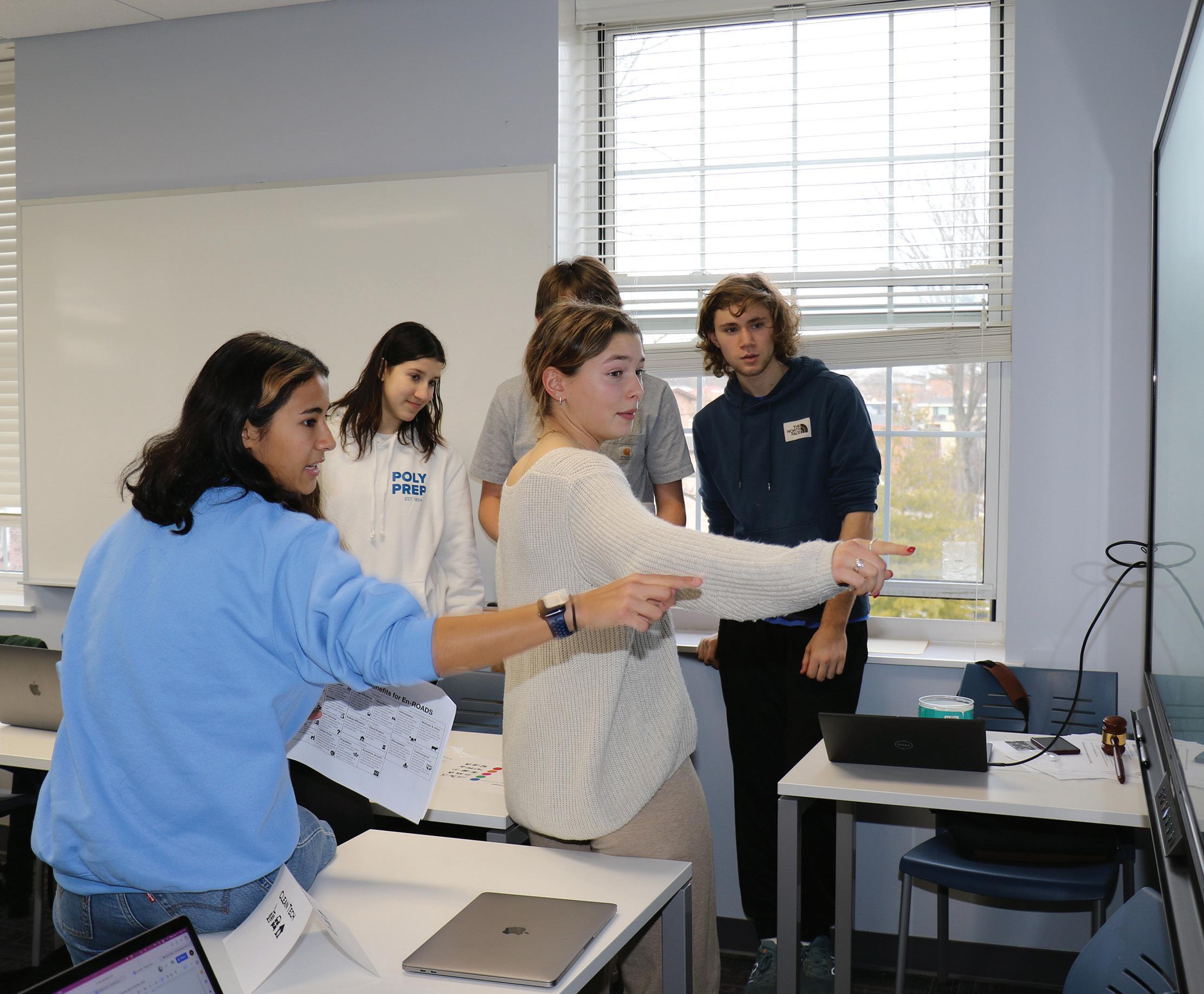
13 POLY PREP COUNTRY DAY SCHOOL SPRING 2023
Zoe Wells ’23 and Nicole Bogdanos ’23 get close to the screen to discuss their En-ROADS moves.
THE FINAL ROUND
Land, Agriculture, and Forestry suggests, “Move afforestation to high growth.” “Change all the way left,” says Maeve Igoe ’23 . “It will lower global temperature, decrease greenhouse gas emissions, and doesn’t hurt the animals. When you move the slider for afforestation, you can see the impact that it makes. The gross CO2 removal increases dramatically. So, as the years continue, there will be more carbon removed from the atmosphere. And this also helps because planting more trees and forests and restoring old forests creates new jobs and in non urban settings the trees produce a canopy that helps the heat effect, which also conserves energy so you do not have to use coal or other non renewable sources of energy to power air conditioners.”
Climate Justice suggests, “Move renewables up to highly subsidized.” Lively negotiation takes place between Conventional Energy and Climate Justice and a final round of urgent talks between Conventional Energy and Industry and Commerce.
Amazingly, they get down to +1.8 degrees. Jack Levin ’24 from Climate Justice counters, “A lot of developing countries are using high rates of carbon emissions and to raise carbon prices on countries that don’t have the resources and technology to reduce carbon in their production, you are keeping the richer countries richer and the poorer countries poorer.”
Clean Tech suggests setting 2030 as a goal. Jiang explained, “Right now people are relying on fossil fuels because they are the cheapest option. And that is because we haven’t taken our resources to research and develop renewable energies or other new sources of energy. If we have this economic pressure to invest in those technologies, perhaps 40 years down the line those technologies will be way cheaper than fossil fuel.”
They return to +2.0 Celsius—their goal! Success at last?
Until, Conventional Energy suggests moving “carbon prices to status quo.” Now they are back to +2.3 Celsius!
Industry and Commerce suggest “moving energy efficiency to high in transportation.” Now they are back down to +2.1. After a last round of negotiation, they finally reach their goal of +2.0 degrees Celsius.
In the Clean Tech group, Jiang explained afterward, “Our priorities included electrifying all industries, investing in renewable energy, and taxing fossil fuel energy sources. Having to adhere to these priorities was the major stumbling block in reaching compromises with other groups who may have vastly different interests, such as the Industry and Commerce group, which was interested in maintaining low prices for fossil fuel energy sources in order to protect the global economy.”
With a big smile, Dr. Solvercan proudly announces that this Poly class is his first class, including college students, to have achieved the +2.0 degrees Celsius mark in the conference.
Dr. Laungani brought to their attention that no two groups had the exact same sliders. “There are a lot of ways to get there, a lot of ways to do this.”

14 THE BLUE & THE GRAY
Dr. Solvercan points to the +2.0 goal on the simulation as Industry & Commerce and Clean Tech debate through surrogates Keelin Walshe ’23 and Tesvara Jiang ’23, respectively.
CONFERENCE DEBRIEFING
At the close of the conference, Dr. Laungani, who shed the alter ego of Dr. Solvercan, asked the students to “sit, think, reflect on what we did…. You came to a global agreement!”
But students realized that it was “easier to do on En-ROAD” than in real life, where there would be consequences of their decisions and “real-life ramifications.”
The experience was eye-opening for students who came to realize that this type of exercise in the real world is “not so simple, not so right and wrong.” Zoe Wells ’23 , of Conventional Energy, said, “In real life, we [from a Conventional Energy perspective] wouldn’t have signed this agreement.”
Igoe said she realized how difficult coming to agreement in a real climate
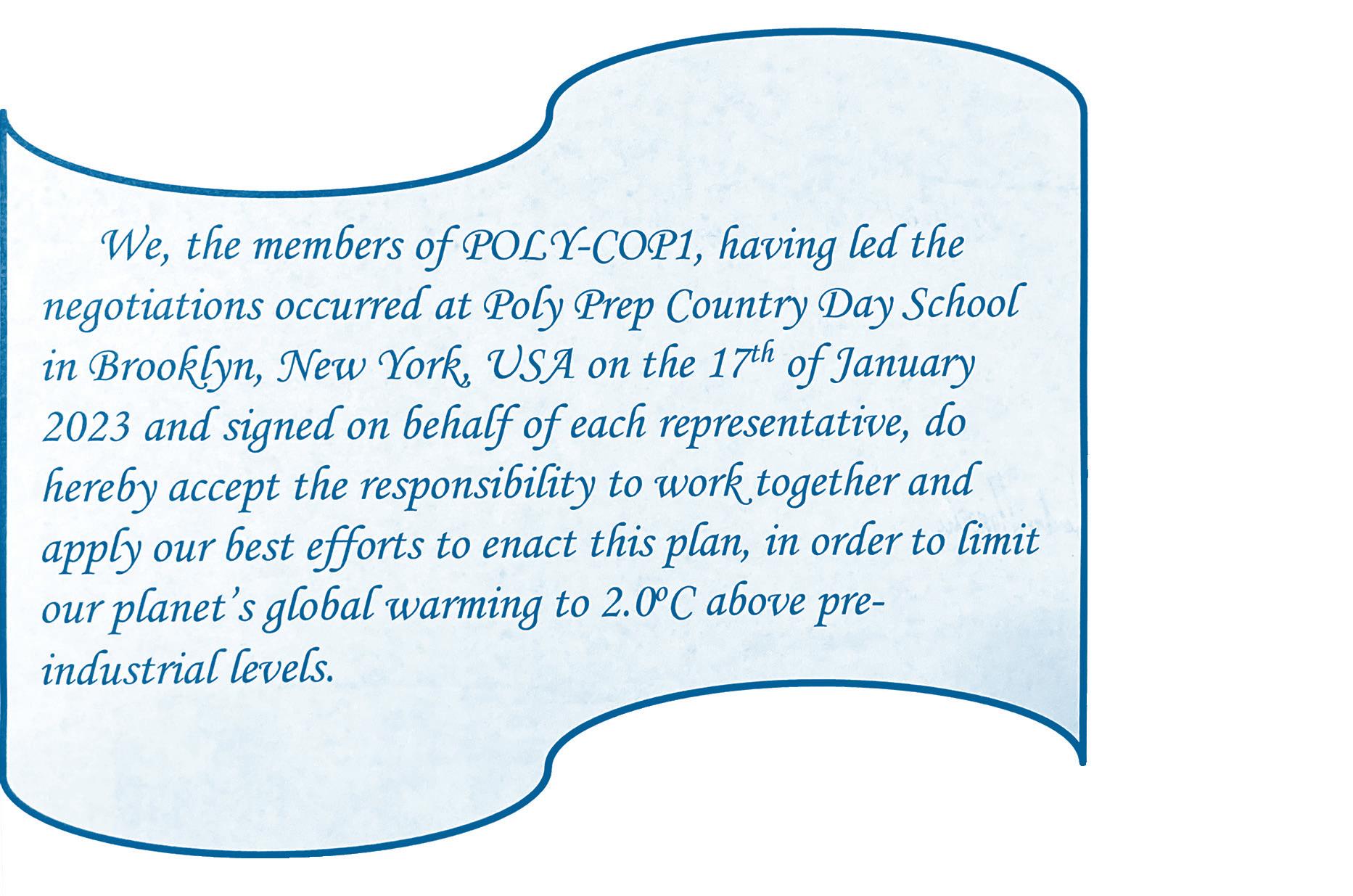
conference might be. “In the most recent COP conference,” she said, “there were over 200 countries there and they had to decide on an outcome in four days while in our conference there were only five group scenarios and it was extremely hard to get to under 2 degrees Celsius and we didn’t have to deal with politics in our scenario.”
“I learned that climate change is a huge problem that everyone on Earth must face,” said Jiang. “If we do not address climate change, we can see global temperatures rise by around 6 degrees Fahrenheit by 2100, which has vastly negative implications on animal life, our economy, our health, and every other aspect of our lives. I agree that the Clean Tech group did have very idealistic views on how we can battle climate change, but reaching the ideal is probably what we need right now.”
Lissak concluded, “Any change has to be gradual.”
After the debriefing, Dr. Laungani said he thought the students recognized a few things: “There is no silver bullet solution to solving climate change; compromise is tough, but needed, and possible; there are many ways, with our current set of tools, to address this global challenge. One student highlighted that not every country has to do all the sliders as they laid out, but different countries could do different parts of this global plan to achieve a common global resolution to this challenge; sometimes 0.1 degree of change is difficult to achieve, but also each 0.1 degree of change is important as well for the future of the planet and for the future of humanity, and through this exercise the students at Poly got to see this firsthand and envision how to build the world that they want to live in.”
SIGNATORIES
Dr. Climateson Solvercan
Dr. Ramesh Laungani
Nicole Bogdanos
Asher Cohen
Abigail Contessa
Marie Culmine
Theodore Drye
Penelope Elgort
Adele Hoinacki
Maeve Igoe
Tyler Jacobus
Tesvara Jiang
Jack Levin
Hayden Lewis
Alida Lissak
Bennett McKeon
Olivia Umeh
Rohan Unis
Keelin Walshe
Zoe Wells
15 POLY PREP COUNTRY DAY SCHOOL SPRING 2023
Just like on the popular TV show, budding entrepreneurs faced the Poly Sharks with creative pitches to win the hearts and prizes of the panel. Math Department faculty member and Poly Shark Dr. Stephen Bates shares the winning entries.

Holden Pawlak ’24 created Trax Tax to bring transparency and citizen connection to taxpayer dollars. Seeing exactly where taxpayer dollars go gives people a sense of fulfillment and allows them to further evaluate who they want to control those dollars. I voted for Holden’s creation because I think it is important for taxpayers to know exactly where their dollars are being spent; this would also help to keep policymakers accountable. Yes, this data might exist in multiple places on the internet, but having it compiled in one place would be phenomenal.
Anjali Budhram ’24 created Poly Pal, an app which would serve as a home base for students’ everyday Poly needs. They could easily access grades, Google Classroom, Veracross (the Student Information System), etc. all in one place. I voted for Anjali’s app because I think it would help make students’ lives easier, improve their organization, and help consolidate the number of apps they need to access on their phone.
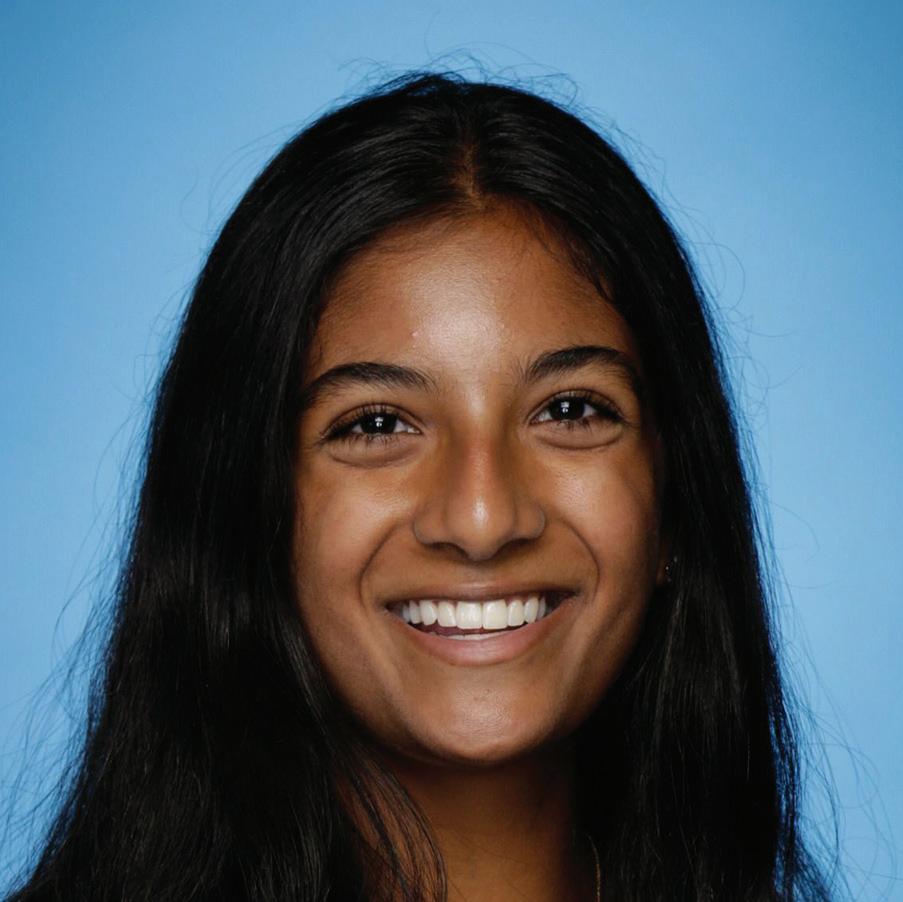
16 THE BLUE & THE GRAY
YOUR WAY.
Planned Giving is simpler than you think, especially at Poly Prep. If your goal is to conserve your estate, create life income, or reduce future tax liabilities for heirs, it’s time to consider the Joseph Dana Allen Society.
Named in honor of Poly’s longest serving head of school, the JDA Society recognizes donors who have named the school as a beneficiary in their will, insurance policy, or retirement account. Charitable gift annuities, charitable remainder trusts, and the donation of non-cash assets are also practical options for alumni and friends.
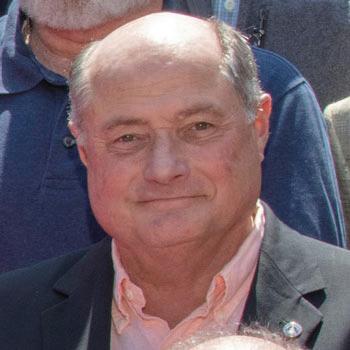

Working with your financial planner, we can structure a legacy gift that will memorialize the values most important to you, maximize your philanthropic giving, and make a smart plan for the future. If you’ve already included Poly Prep in a bequest or other planned gift, please let us know so we can express our gratitude and recognize you for your generosity as a member of the JDA Society.
We’re happy to help you get started on a legacy gift to Poly Prep. Go to polyprep.mylegacygift.org or contact:
Peggy Cook, Chief Advancement Officer pcook@polyprep.org (347) 394-1169
Donna Muoio P’13, ’17, Director of Alumni Relations dmuoio@polyprep.org (718) 663-6031
Keith Wiggs, Director of Major Gifts kwiggs@polyprep.org (347) 394-1164

“I am forever grateful to Poly for the emphasis on mind, body and character taught in the classrooms, on the athletic fields and in the relationships with my classmates—then and now.”
—Eric J. Ruby ’64
“The gift to Poly contained in my will is in memory of my father, in recognition of Poly’s generosity and my hope that my gift will benefit a young student from Brooklyn needing financial aid.”
—Joseph Hanson, Jr. ’68
polyprep.mylegacygift.org
YOUR LEGACY.
“Africa was a powerhouse at one time,” said Grade 4B teacher Aiyana Parker. During the monthlong unit on African history, Parker taught students about the impact the African kingdoms of Punt, Carthage, Ghana, Mali, Songhai, Kush, Axum, Mutapa, Great Zimbabwe, and Benin had on the modern world. The penultimate activity of the unit was hands-on and interactive: The Great African History Museum. Grade 4 students research the African kingdoms using the elements of civilizations (G.R.A.P.E.S.: geography, religion, achievements, politics, economics, and social structure) and created replica artifact items. Over the course of three days, classes were able to visit the museum, including exclusive times with guided tours by the fourth graders.
M
18 THE BLUE & THE GRAY
Sloane M. ’31 described to kindergarten students how she built her project about the kingdom of Mutapa. She created a replica of the Great Enclosure in Zimbabwe. This palace is believed to have served as the home of the local monarch. Mutapa was an African kingdom in Zimbabwe, which expanded to what is now modern-day Mozambique.

Erin B.’s artifact, a recreation using clay, paper, and pencil, is of the 16th century ivory pendant masks from Benin that are thought to have been produced to honor the Queen Mother Idia and used in commemoration ceremonies. The Portuguese merchants depicted in the carving symbolize their power over the European traders and the wealth they brought to the city-state.

M B BENIN IVORY PENDANT
MUTAPA
ARTWORK: ERIN B.
19 POLY PREP COUNTRY DAY SCHOOL SPRING 2023
ARTWORK: SLOANE M.
Z GREAT ZIMBABWE
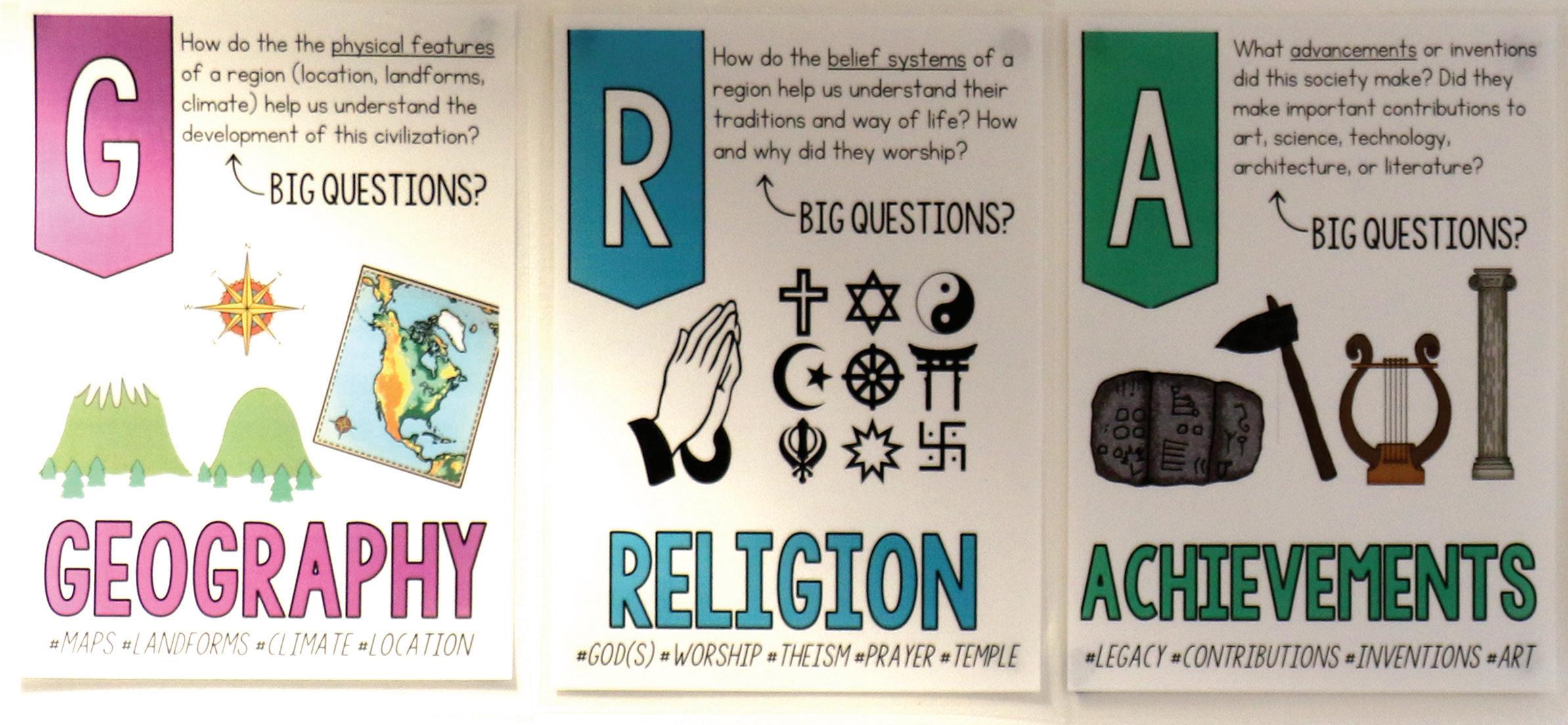
Great Zimbabwe was built by the Bantu civilization of the Shona between the 11th and 15th centuries. The city was an important trading center from the Middle Ages and beyond. Archaeological excavations have unearthed a treasure trove of artifacts, including the stone bird recreated by Henry K., which is the national symbol of Zimbabwe. Other items from the site include glass beads and porcelain originating from China and Persia, and gold and Arab coins from Kilwa. Ceramics and ironware provide evidence of the civilization’s socio-economic complexity, as well as farming and pastoral activities.

20 THE BLUE & THE GRAY
ARTWORK: HENRY K.
O HEAD OF AN OBA
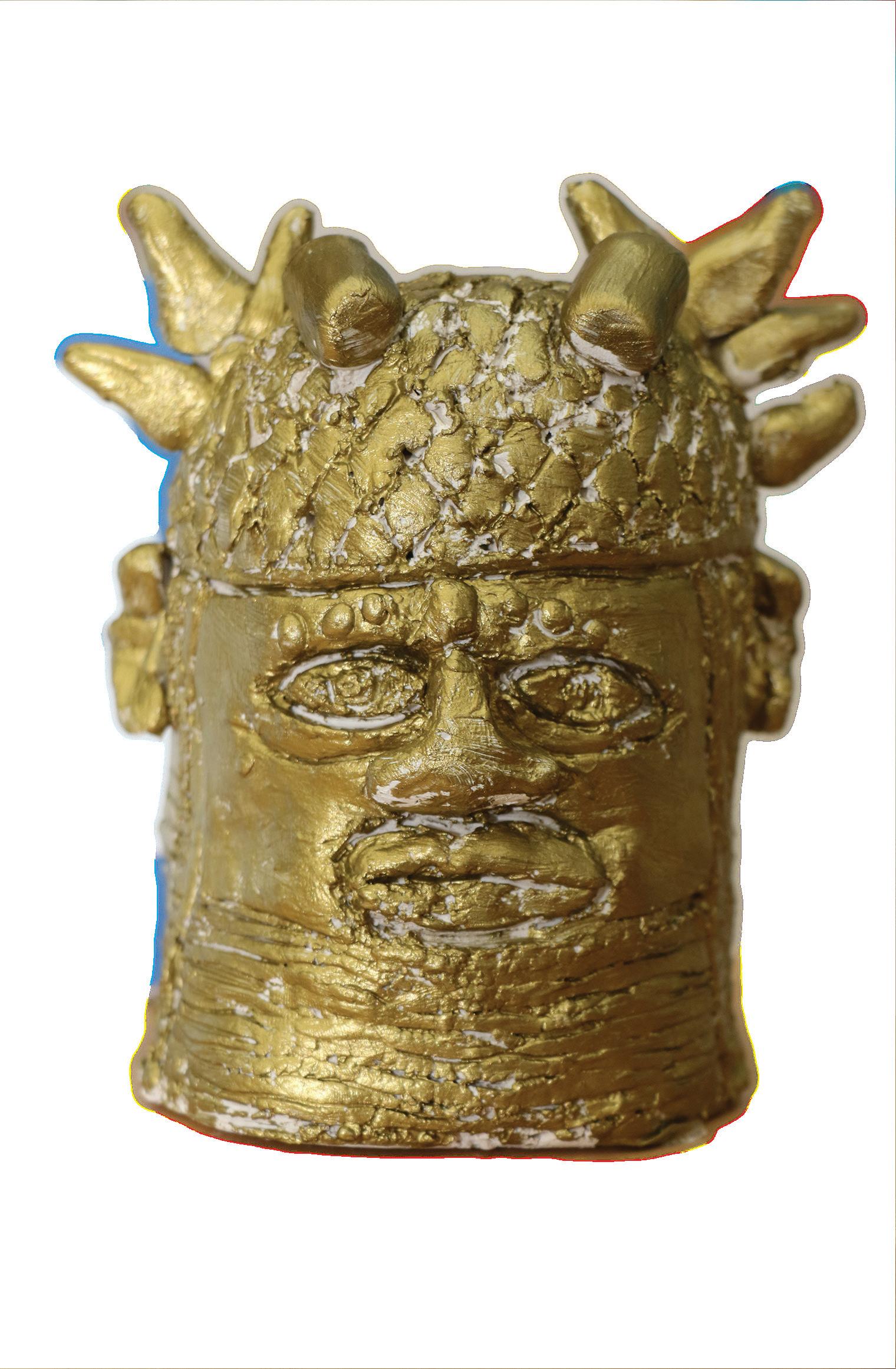
The obas (kings) of Benin trace their origins to a ruling dynasty that began in the 14th century. The title of oba is passed on to the firstborn son at the time of the ruler’s death. Each new oba of Benin began his reign by creating a shrine to his predecessor. Freestanding heads, such as this one made by Circe W., were placed on the shrines as symbols of the qualities and leadership of the previous ruler.

21 POLY PREP COUNTRY DAY SCHOOL SPRING 2023
ARTWORK: CIRCE W.
C CARTHAGE
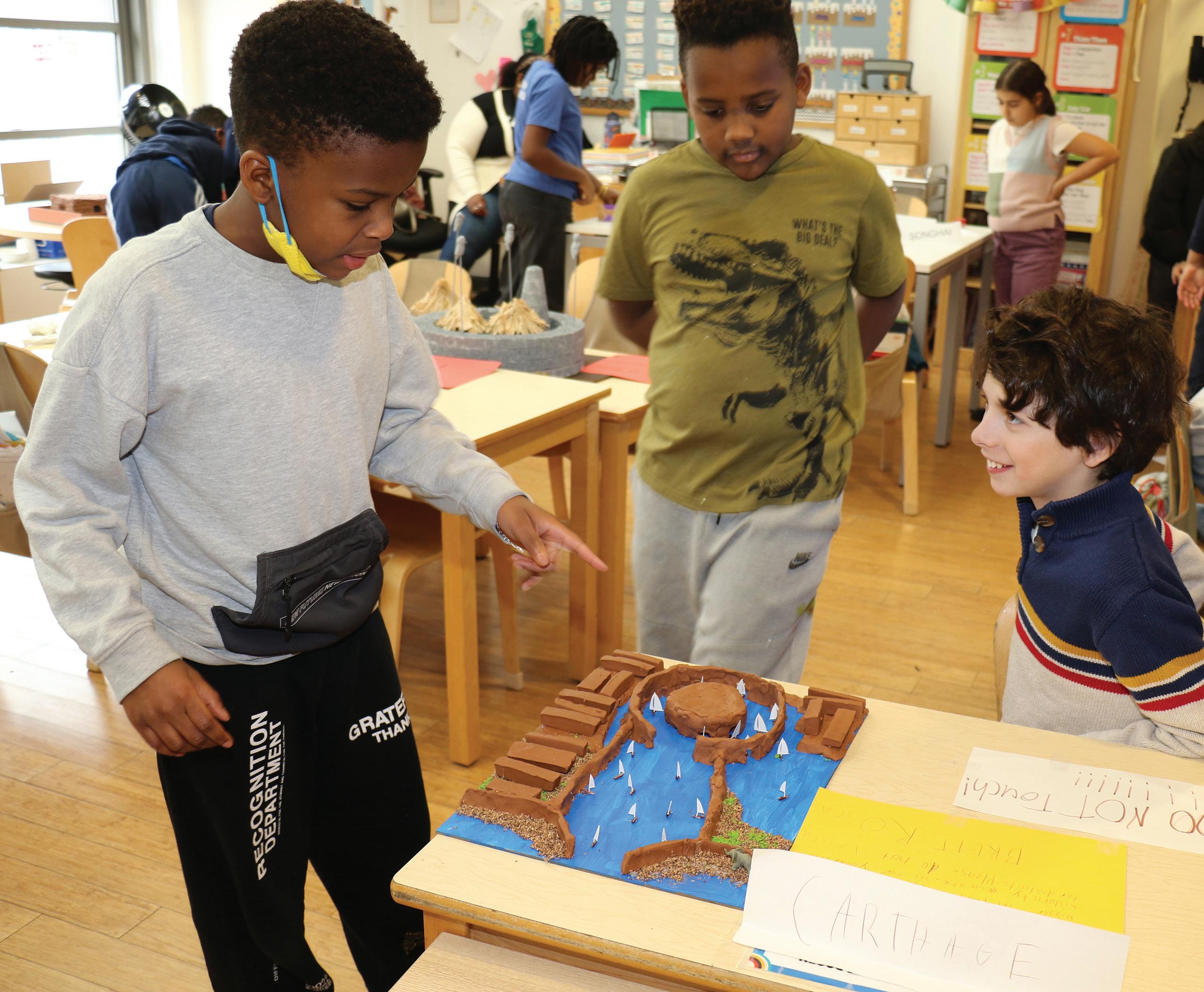
ARTWORK: BRETT R.

22
ARTWORK: POPPY J.

Before the rise of ancient Rome, Carthage (present-day Tunisia) was the most powerful city in the region and the center of the Phoenician trade network. Brett R. recreated its formidable harbor complete with tiny sailing ships. In another scene, Poppy J. imagined what Hannibal looked like atop a war elephant in 218 B.C.E. as he crossed the Alps from Carthage to Italy with 30,000 soldiers, 15,000 horses, and 37 elephants in the Second Punic War.
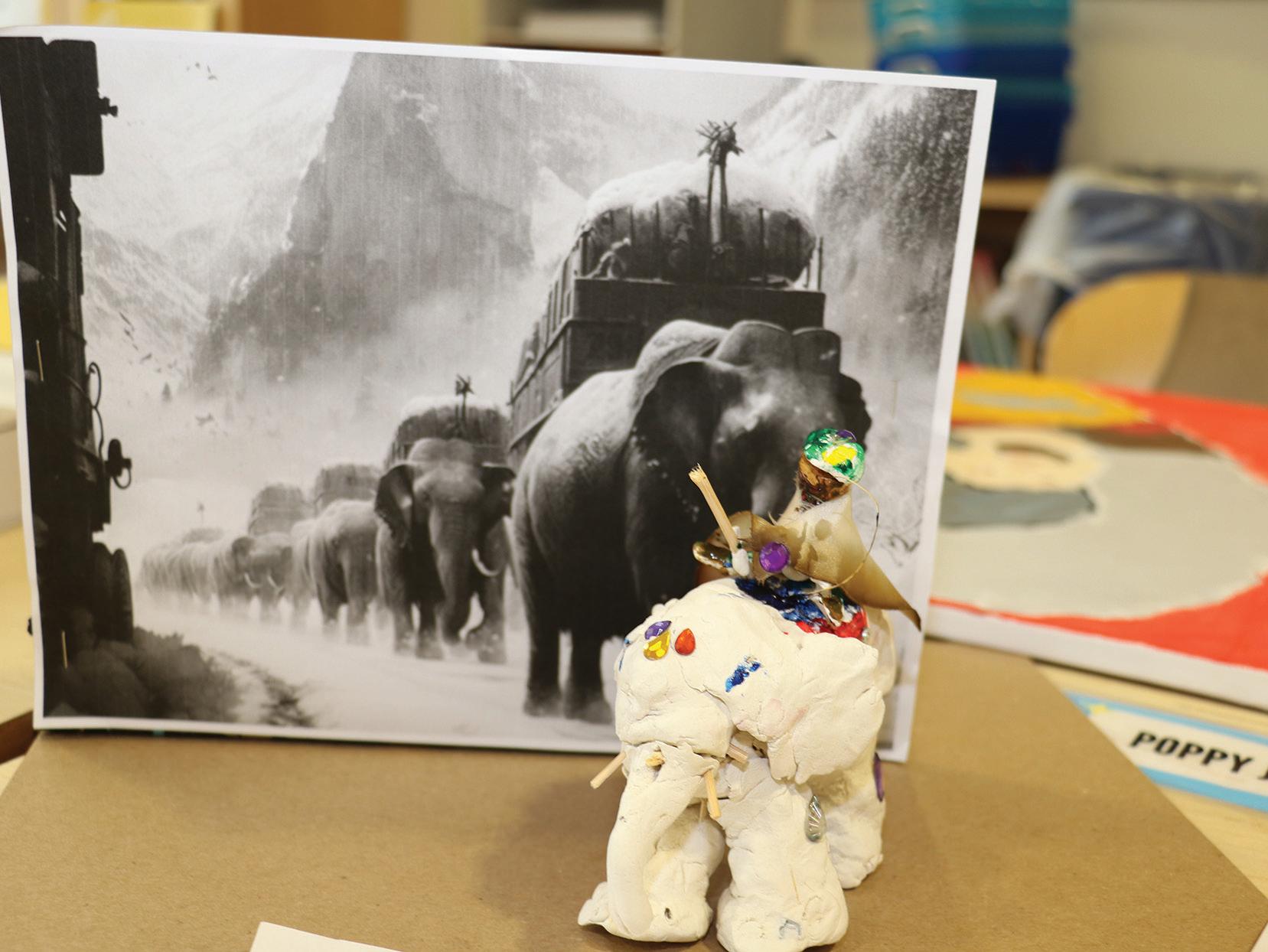
23 POLY PREP COUNTRY DAY SCHOOL SPRING 2023
P PUNT
Punt was a major trading partner of Egypt for more than a millenia. It produced and exported gold, alloys, blackwood, ebony, ivory, wild animals, and also aromatic resins that were used to make incense and used in burners, like this one made by Noah J. Claire T. created a likeness of female pharaoh Hatshepsut (right) whose expedition to Punt in the 15th Century B.C.E. is the best source of information on the ancient city providing clues to its location. Gabriel A.’s Land of Punt exhibit (below) showcases their houses on stilts.
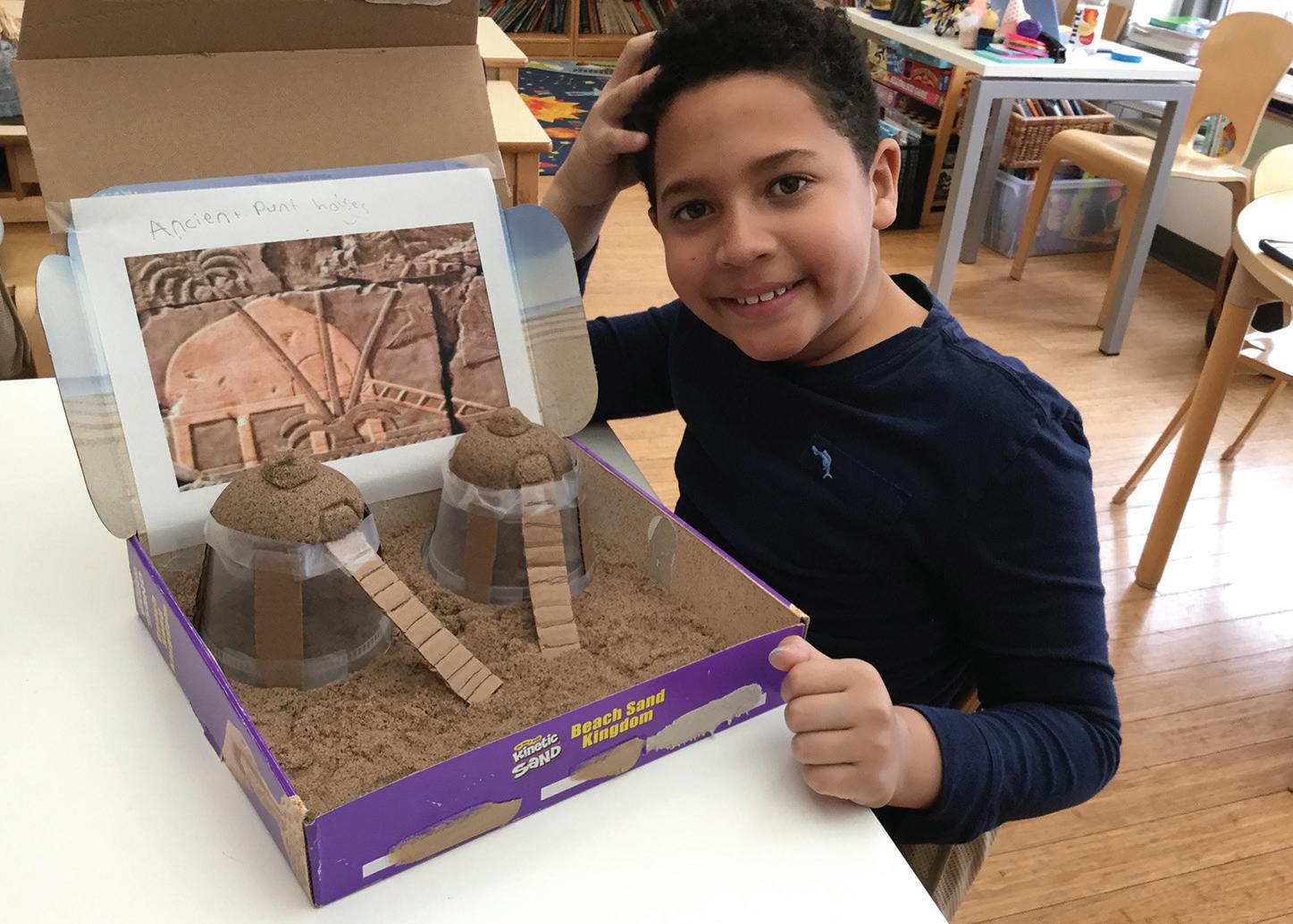
 ARTWORK: NOAH J.
ARTWORK: NOAH J.
24 THE BLUE & THE GRAY
ARTWORK: GABRIEL A.
ARTWORK: CLAIRE T.

25 POLY PREP COUNTRY DAY SCHOOL SPRING 2023
Joseph McElroy ’47 wa s the speaker in the inaugural Poly Writers @ Poly event. The novelist took the audience of students and faculty in the library on a fascinating journey through his writing process during a literary lunchtime talk and Q&A. The Alumni Office hosted the event and several alumni also joined on a Zoom link on October 27. 50
Melissa Davidson ’88 left a job as a public librarian after 13 years, and is now enjoying her free time in the beautiful Shenandoah Valley of Virginia.
Robert Stern ’51 has been living at his apartment in the Upper East Side for over 66 years. Pictured here is Bob with a painting he did for an art contest at Poly in his senior year that won first prize—he joked it was maybe an award of $5. 60
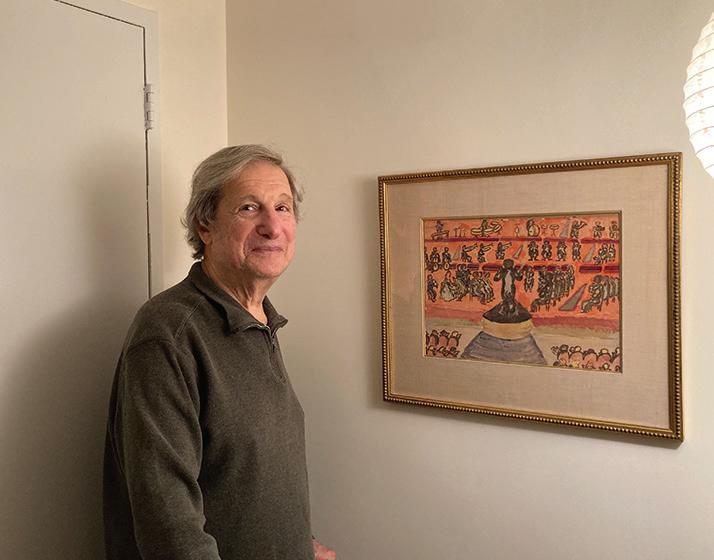
Michael Kearns ’89 married Jason Smith on May 26, 2022, at the Arapahoe County courthouse outside of Denver on their 15th anniversary together. After working as an energy lobbyist in DC for over a decade, Michael earned a master’s degree in social work from Howard University in 2016. After moving to Denver in 2018, he worked as a psychotherapist until retiring in 2022.

Ma rissa Beck ’01 continues her career as a Registered Dietitian Nutritionist (RDN) and recently became the founder of REVV Health, a wellness vendor providing online nutrition counseling and corporate education, “to help people perform better in their everyday life.” She lives with her husband and two girls in Mercer Island, Washington.

Dw ight Cobb ’65 enjoyed attending the regional luncheon in Boca. He has relocated full time to Delray Beach, Florida with his wife, Dawn.
Anthony Sgarlato MD, FACP ’74, af ter a fulfilling 33-yearcareer of practicing internal medicine in Brooklyn and Staten Island, working as a senior medical investigator for the Office of the Chief Medical Examiner of the City of New York, and as a medical director of a substance abuse clinic in Brooklyn, has accepted the position of adjunct professor at Wagner College in the Physician Assistant program.
70
David Alperin ’97 and Michelle Lorenzutti Alperin welcomed their baby girl Paloma Linda Alperin on December 29, 2022.

Keyonte Sutherland ’03 enjoys bringing son, Wyatt, to all of our campus events. Wyatt, of course enjoys watching his big brother Aaron ’26 compete for Poly, but most importantly spending time with the Blue Devil.
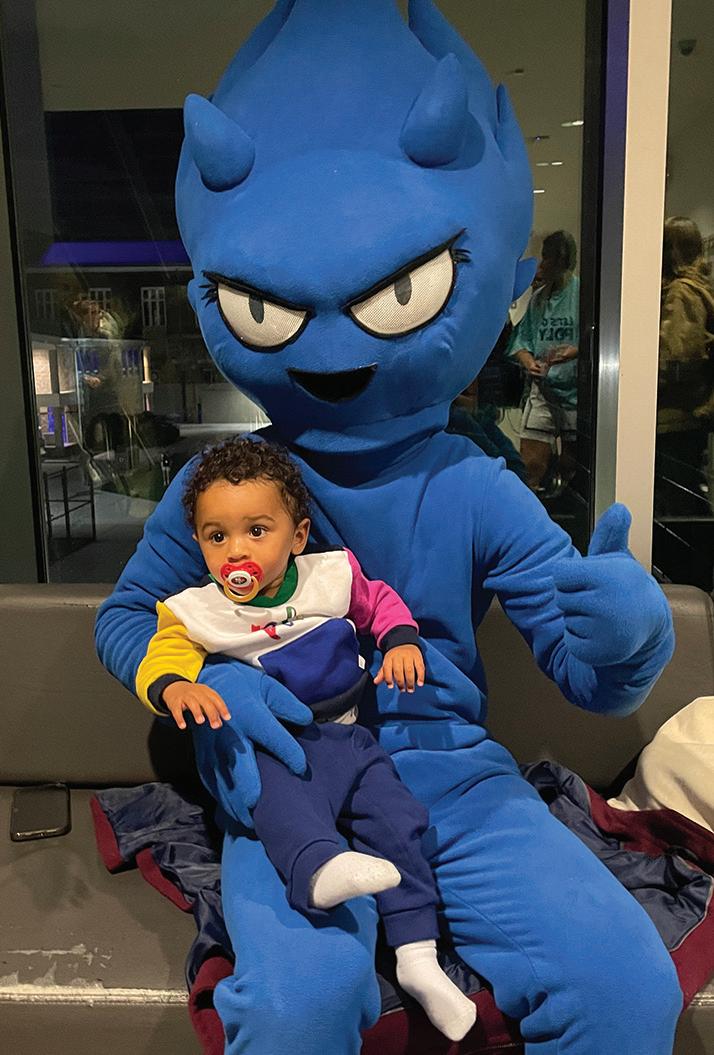
CLASS NOTES
40
80
90
00
26 THE BLUE & THE GRAY
TH E CLASS OF 2005 WEDDINGS: IN 2022 THREE MEMBERS OF THE CLASS OF 2005 TIED THE KNOT AND CELEBRATED WITH MANY OF THEIR CLASSMATES.
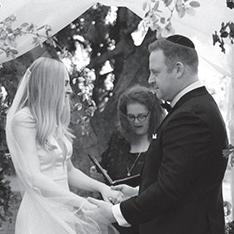





Sh annon Cohall ’10 had the privilege and honor of being sworn in and admitted to the Bar in New Jersey by the Honorable Fabiana Pierre-Louis, NJ Supreme Court Justice on December 2, 2022. Shannon is now officially an Attorney at Law!
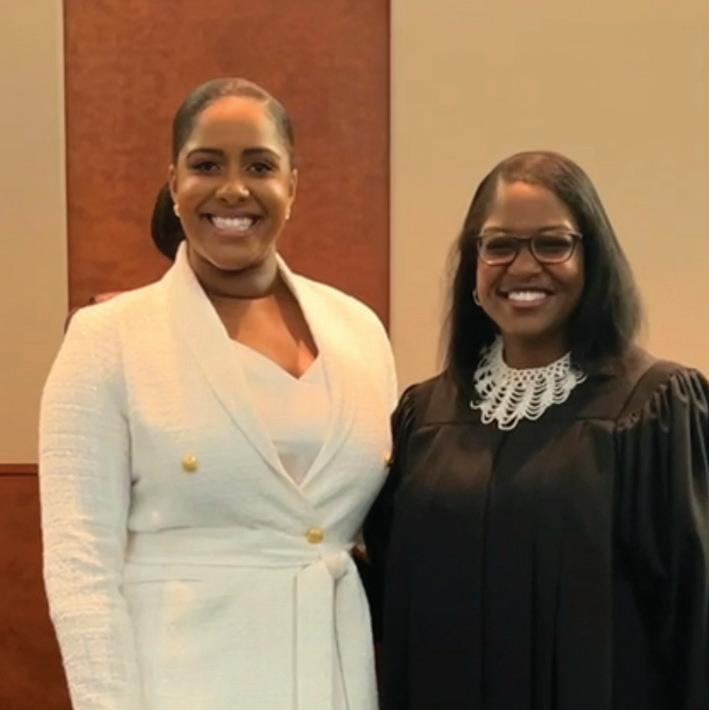
Sydney Marcus ’15 is living in London, leading design for Toshi Technology and enjoying life.
Eddie Hayes ’16 is excited for his new journey as an analytics rep at Bloomberg.

Maddie Winter ’18 and Liat Weinstein ’18 returned to Poly (Weinstein via Zoom) on October 27 to talk about their experience reporting the Polygon story “How We Talk When We Talk About Race,” with Rachael Allen’s Advanced Journalism class, many of whom are current Polygon staff members. Winter graduated from Princeton and Weinstein from the University of Michigan last year. Weinstein said that she continued her journalism career as a reporter on her college paper. They were joined on the panel by Dr. Virginia Dillon, who was advisor to The Polygon at the time of the article’s publication.
James Seaton ’15 returned to speak on “Embracing Empathy” in the opening assembly of Poly Connected, a day of Middle and Upper School Diversity, Equity, Inclusion, and Belonging (DEIB) workshops on January 25, 2023.
Da rby Steininger ’21 , a sophomore at University of Miami’s School of Communication, recently became one of the hosts on UMTV’s Newsbreak—a fastpaced news headlines show, keeping students in the know.
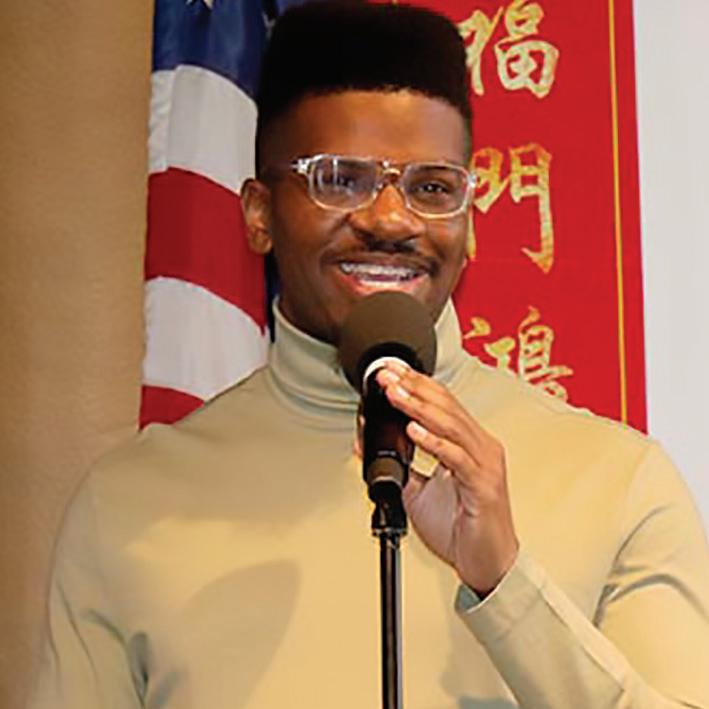
CLASS NOTES
Len Belvedere ’05 married Liana Notini on October 23, 2022 in Livermore, CA.
Paul Lehrman ’05 married Linnea Sage on May 1, 2022 in Puerto Rico.
10
David Mash ’05 married Elizabeth Healy on May 27, 2022 in Charleston, SC.
20
27 POLY PREP COUNTRY DAY SCHOOL SPRING 2023
1940S
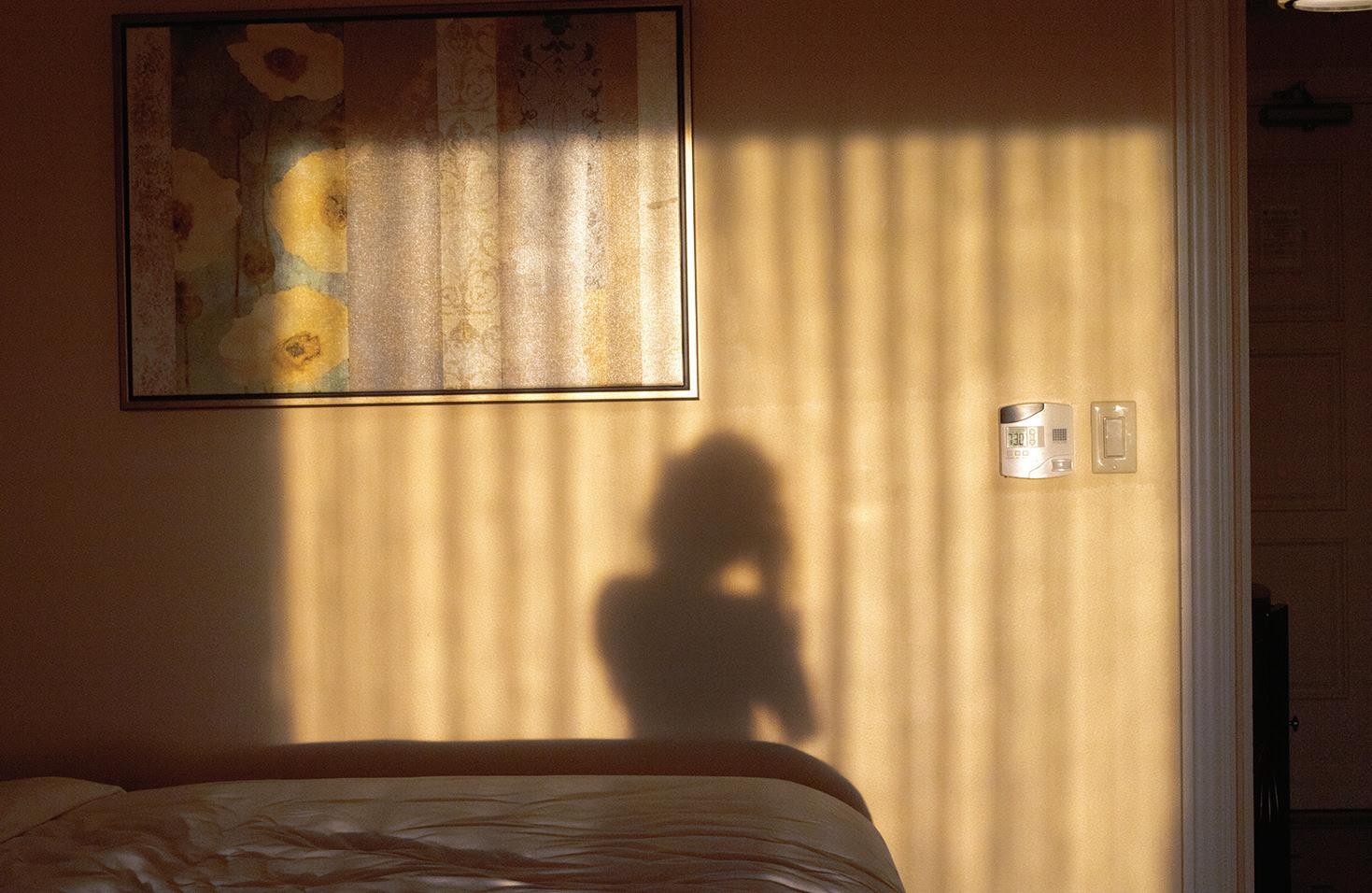
Melvin L. Fraiman ’42 , 98, of Sarasota, FL, passed away on October 20, 2022. Melvin was born in Brooklyn, NY, a son of Herbert and Diana (Rubenstein) Fraiman. He was the beloved husband of the late Beatrice Z. Fraiman, with whom he shared 72 years of marriage prior to her passing in 2021. He is survived by his devoted children: Douglas and his wife, Johanna, of Homer, AK; Yedidya and his wife, Susan, of Jerusalem, Israel; and Richard and his wife, Lenie, of Lincoln, MA; his loving brother, Robert, of Indian Wells, CA; 13 cherished grandchildren, 15 treasured great-grandchildren, and several nieces and nephews.
Bernard L. Spence ’45 of Wallingford, CT, passed away on August 28, 2022 at 95. He was born in New York City on January 11, 1927, son of the late Bernard and Ruth (Straat) (Haldeman) Spence. Bernard attended Poly Prep and held two degrees from New York University. He served as an aviation machinist mate in the Navy during the latter part of World War II, based at the Charlestown, RI naval air station working on the F-8 Bearcat and the 74U Corsair fighter. He started his career at the Halsted School in Yonkers, NY and retired from the Scarsdale, NY school system where he taught, counseled, and coached for 29 years. Bernard was a lifelong small boat enthusiast and was an active competitive sailor in the Comet, Dyer, and Sunfish Classes. He was past Commodore of the Highland Lake Sailing club and enjoyed square and round dancing with the Buttons and Bows club in Orange. Other hobbies included woodworking, RV camping, and ocean cruising. Bernard was the husband of Marjorie (Traub) Spence for 70 years. He is survived by his sons, David and his wife, Lois, and Bernard and his fiancé, Martha Shook, of Boston, MA; his grandchildren, David, Melanie, Zachary, and Benjamin; and three greatgrandchildren. He was predeceased by his brother, Harold Haldeman, and his sister, Dorothy Haldeman Keefe.
Frank Libassi ’47, a prominent attorney and activist who served in three presidential administrations—John F. Kennedy, Lyndon B. Johnson, and Jimmy Carter—died at age 92 on August 30, 2022 in Bloomfield, CT. Born on April 20, 1930, in Brooklyn, NY, Peter and his wife, Mary Fran, resided in New York City, Albany, and Washington, D.C. before settling in the Hartford area over 50 years ago. Peter had many interests, titles, and awards that illustrate his valuable contributions to the many organizations he served throughout his life. However, his overarching passion was justice, equality, and the betterment of his fellow man. Uniquely qualified to tackle such important issues, Peter brought to bear his inexhaustible energy, perseverance, and innate sense of justice to everything he did. Peter graduated Cum Laude from Colgate University in 1951 and Yale University Law School in 1954. Upon graduation from Yale, Peter was an attorney with the New York State Rent Commission, and from 1956 to 1962, he served as a civil rights attorney with the New York State Commission Against Discrimination. From 1962 to 1966, Peter became the Staff Director of the U.S. Commission on Civil Rights in Washington, D.C. Recognized as an expert on the Civil Rights Act of 1964, Peter was appointed in 1966 as the first Director of the National Office of Civil Rights
in Washington, D.C., reporting to the Secretary of Housing, Education & Welfare (HEW) in the Johnson administration. This appointment allowed Peter to play a pivotal role at the forefront of civil rights issues in the turbulent 1960s. President Johnson’s Great Society ushered in two federally funded programs, Medicare and Medicaid. Though Medicare is not usually recognized as a civil rights program, it was used successfully and peacefully to force hospital desegregation in the U.S. by withholding federal funds if hospitals were non-compliant. Peter and several other key players were able to desegregate U.S. hospitals, physicians’ offices, nursing homes, and clinics within 10 months. In 1977, HEW Secretary Wilbur Cohen stated, “If Medicare and Medicaid had not made another contribution, this result would be sufficient to enshrine it as one of the most significant social reforms of the decade, if not the century.” From 1968 to 1971, Peter did urban development work for the National Urban Coalition in Washington, D.C. He then worked on community development for The Greater Hartford Process, Inc. in Hartford, CT, from 1971 to 1977. In 1977, President Jimmy Carter nominated Peter to be General Counsel of HEW, working on legislation to protect Americans with disabilities against discrimination, among other issues. From 1979 to 1982, Peter was a
OBITUARIES AS OF MARCH 8, 2023
Art by Maggie Cochran ’26
28 THE BLUE & THE GRAY
Partner at Verner, Liipfert, Bernhard & McPherson, a law firm in Washington, D.C. A leader in the Hartford, CT corporate and non-profit communities, Peter was a Senior Vice President in charge of Communication at Travelers Corporation from 1982 to 1993, when he retired. One of his proudest moments at Travelers was the establishment in 1985 of the Travelers Center on Aging at UConn Medical School. After retirement, he served as Dean of the University of Hartford’s Barney School of Business. In addition, he served on numerous boards, including the Children’s Fund of Connecticut and the Bushnell Center for the Performing Arts. Peter was a Woodrow Wilson Visiting Fellow in 1974, 1975, and 1976. He received many awards, the most prominent being the Distinguished Service Award and the Superior Service Citation from HEW, the Meritorious Service Award, and the Superior Performance Award from the U.S. Commission on Civil Rights. Peter attributed much of his success to his law studies. He once said, “the most important thing I learned in law school was how to think.” But it was more than that; his magnetic personality, energy, and drive to make the world a better place contributed to his success and defined his life. Peter enjoyed travel, the symphony, Broadway shows, and spending time with friends, family, and, most importantly, his beloved wife and life partner, Mary Fran. Peter is survived by his wife of 68 years, Mary Frances, his three children: Thomas, Timothy, and Jennifer, his daughter-in-law Loredana Grandis, his grand-daughters and their spouses: Karina and Jarred Hutchison, Antonia and Tucker Bryan, Francesca, Isabella, and Danielle Libassi, and his great-grandson Liam Hutchison. He is also survived by close cousins Jeanne Genovese and Kathy Koubek, as well as many grand nieces and nephews.
Clifford Barr ’48 , a Poly trustee emeritus, passed away on August 18, 2022 in Boca Raton, FL. Born in Philadelphia, Clifford grew up in Brooklyn. He attended Poly, Princeton University, and Harvard Law School. Clifford practiced real estate law at Dewey Ballantine for five years before signing on with Uris Brothers Corporation.
He was instrumental in negotiating leases in many of the city’s gleaming new office towers, including 1301 Avenue of the Americas. In 1973, Clifford became a vice-president at Metropolitan Structures Inc. He was a driving force behind the company’s participation in the Illinois Center project, in the heart of downtown Chicago. Clifford was an avid squash player and proud to become a national champion at age 65. A huge fan of jazz, Clifford amassed a collection of thousands of records. Other interests included swimming and reading The New York Times every day, cover to cover. Clifford was generous, both with his resources and his time. He loved treating friends and family to special gifts, dinners, and trips, but even more important, he was always available to give counsel and support. Clifford will be missed greatly by his family and devoted caregiver, Christina. He is survived by his beloved wife of 67 years, Barbara; sons Brad (Amy), Greg (Rachel), and Todd (Cathy); 11 grandchildren and three great-grandchildren.
David Elias Marrus ’48 passed away on September 2, 2022. He resided in Rumson, NJ and New York, NY. His parents, Seth and Bertha (Stern), initiated his lifelong curiosity and the passions for travel and photography he would cultivate throughout his life. He began his education at Poly and then went to North Carolina State College. He served in the army during the Korean War. Having already made a host of lifelong friends, he started his career with the International Business Machines Corporation. During his time at IBM, he married the love of his life, Judi. Later, he went on to help develop Roosevelt Island while at the Urban Development Corporation, before serving as Chief Operating Officer and Vice President of I.B.E.C. Housing International. Subsequently, he directed Starrett Housing International’s overseas activities as the firm’s president. These experiences led to his consulting in the real estate industry, where he was particularly proud to facilitate the first expansion of the Museum of Modern Art, along with the related construction of the Museum Tower in New York City. Throughout his career,
he honed his appreciation for and skill with photography, which culminated in his two personal monographs, Viewpoints and Pictures from My Album , each of which contained his favorite images from years of widespread travel with his wife, Judi. These images, along with a large and fascinating collection of photographs and art brought an unmistakable warmth and texture to the walls of their home. He deeply enjoyed his life, swimming in his pool and watching the birds in the backyard, but he missed his dear Judi greatly over the last 14 months. David was a noble, virtuous, and highly principled man with a deep philanthropic sense, greatly respected by his many friends and colleagues. A past President and Life Trustee of The Congregation Temple Emanu-El of New York City, he was also a member of the Lotos Club, Hollywood Golf Club, and a past President of the Ocean Beach Club where he spent summer days floating in the ocean. David was predeceased by his wife, Judith. His pride in his children, Michael and Lauren (Winer) and Andrew and Jennifer (Kochman), was boundless as was his great love for his grandchildren, Samantha, Jacob, Ryan, and Evan.

OBITUARIES AS OF MARCH 8, 2023
29 POLY PREP COUNTRY DAY SCHOOL SPRING 2023
Art by Emilia Fusaro ’25
1950S

Major Philip V. Moyles, Sr. ’50 (USMC Retired) of Belmar, NJ, and New York City, NY passed away on February 3, 2023. He was the son of William P. Moyles, a former secretary to Supreme Court Justice Charles Dodd, and Margaret K. Moyles, the first female to receive her Doctorate of Law from Brooklyn Law School. Born on September 16, 1931 in Brooklyn, NY, Philip led a life full of education, faith, and service. He graduated from Poly, Mount St. Mary’s University, and University of Virginia Law School. He was a retired major of the United States Marine Corps and, after running for the U.S. Congress, he became a dedicated attorney with a practice focused on maritime law. He was admitted to practice in the U.S. Court of Appeals 2nd, 5th, and 11th Circuits and the State Courts Circuit of New York. He tried cases in U.S. Districts Courts of New York, Florida, Texas, and Oregon and participated as a delegate of the Comité Maritime Internationale in Montreal (1981) and Venice (1983). Philip was a member of the American Bar Association, the New York Bar Association, and the Maritime Law Association and was a frequent guest lecturer at the Tulane University
Law School, Admiralty Institute. He was committed to education and he helped start the Marine Corps Scholarship Foundation in NYC in the 1960s, where he was on the Board of Directors. He belonged to the USMC Heritage Foundation, the USMC Association Foundation, the National Maritime Historical Society, and the U.S. Naval Institute. He also established a PreLaw Scholarship honoring his parents at his alma mater Mount St. Mary’s where he was honored with several awards including the President’s Award in 2020. His most important role was that of a loving and dedicated father and grandfather. He is survived by his four loving children, Philip V. Moyles, Jr. (Beth), Christine M. Kovan (Ken), Lynn M. Belletier (Bob), and Dana Moyles Eberle (John). He will also be greatly missed by his five grandchildren, Philip III, Kate, Emma, Mathew, and Henry. He is also survived by his sister Mary Jane Murray of New Rochelle, NY. He was predeceased by his parents, William and Margaret, and his brothers, Bill, Kevin, and Quentin.
Ronald J. Newmark ’50, of Boynton Beach, FL, passed away on September 23, 2022 at 89. Ronald was born in Brooklyn, NY to Bertha and Ralph Newmark on January 12, 1933. He grew up with his sister, Jacqui. He attended Poly Prep and then graduated from the Wharton School of the University
of Pennsylvania in 1954. While in college, he met his beloved Helen, of Seguin, TX. They were married in 1956. Shortly after they were married, Ron was drafted into the army and was stationed at Fort Benjamin Harrison in Indianapolis, IN. In Indianapolis, they had three children, Gregg, Jay, and Nancy. After his service in the military, Ron joined the independent insurance agency, Affiliated Agencies, where he became a partner and worked for over 40 years. In Indianapolis, Ron was a civic leader, serving on the boards of directors of many not-for-profit and community organizations including the American Red Cross, the Jewish Welfare Federation, the Indianapolis Hebrew Congregation, and the Children’s Bureau of Indianapolis where he served on the board and as board president. Ron was a dedicated husband, father, and grandfather. He loved gathering the family for holidays, family celebrations, and reunions. He enjoyed being an active participant in the lives of his children and grandchildren. In addition to his wife, Helen, and his three children, Gregg Newmark (Jodi), Jay Newmark, and Nancy Liffmann (Reid), Ron is survived by his sister, Jacqui Tenzer, and nine grandchildren: Allison, Rebecca, Daniel, Deborah, Amanda, Lauren, Max, Josh, and Zachary.
Reverend Richard M. Louis ’51 died on November 12, 2022 at the age of 89. Richard was born in Brooklyn, NY to Mortimer and Olga (Paulson) Louis. After Poly, he graduated from Colgate University (’55). While at Colgate, and after meeting The Rev. Harrison Hadley and his wife, Annette, Richard was confirmed an Episcopalian at St. Thomas’ Church in Hamilton, NY. Richard attended the Episcopal Theological School in Cambridge, MA, and after graduating, served as a hospital chaplain at St. Luke’s Hospital, as well as Memorial Sloan Kettering Hospital in New York City, where he ministered to children with cancer and their families. It was at St. Luke’s where he met M. Kristan Bertelsen, and they married in 1965. They had two boys, Paul Christian Louis and Andrew Richard Louis, and raised them in New Jersey. Richard began his service in the Diocese of Newark
OBITUARIES AS OF MARCH 8, 2023
30 THE BLUE & THE GRAY
Art by Lena Shamos ’25
in 1970 when he became the Rector of St. Mark’s Episcopal Church in Teaneck, NJ. He was then called to St. John’s Memorial Episcopal Church in Ramsey, NJ in 1979, where he served as rector until his retirement in August 2000. Richard was beloved at both St. Mark’s and St. John’s, where he was responsible for growth and unity at both parishes. Upon retirement, Richard continued to serve the Diocese of Newark as a supply and interim priest for a host of parishes, and by mentoring other priests. Richard believed that the purpose of the church was outreach and inclusion. Before offering communion, he would remind the congregation that “This is God’s table, and we are all God’s children and welcomed here.” Richard was responsible for many improvements at both parishes, including the installation of a “diversity” stained-glass window at St. Mark’s, a new pipe organ at St. John’s, and many other improvements designed to make the churches more inviting and inclusive to all who entered and participated. Richard will be remembered for his pastoral skills. He was approachable and reassuring—a steady, dependable, and stable presence. When he conversed with you, you were his focus. If you had a problem, he was there for you. Through connection and compassion he gave people strength and confidence in times of stress and uncertainty. And notwithstanding the high example he set for other clergy, he remained modest, and his ministry was never in the service of his own needs. As a pastor, friend, father, and husband, Richard will be remembered for his insight, patience, wit, and grace. Richard was predeceased by his son, Paul, and his grandson, Desmond Singh Louis. He is survived by his wife, Kristan, brother,
James Paul Louis, son, Andrew, daughterin-law, Rajdeep Kaur Sandhu-Louis, granddaughter, Raika Kaur Louis, and grandsons, Toran Singh Louis and Amer Singh Louis, as well as many, many nieces and nephews.
Ivar Pelle Aavatsmark ’52 , of Lebanon, TN passed away peacefully on New Year’s Day, 2022. He was born on Sept. 7, 1934 in New York City, residing in Bay Ridge’s “Old Colony” Scandinavian community with his father, Pelle Aavatsmark (19041993), and mother, Connie Nilsson Aavatsmark (1910-1949). He grew up during the Great Depression, where he was influenced by his father’s work at the Greater New York Fund, a charity that provided assistance for unemployed New Yorkers. Ivar attended Poly Prep for Middle School, and boarded at Loomis (now Loomis Chaffee) in Windsor, CT.
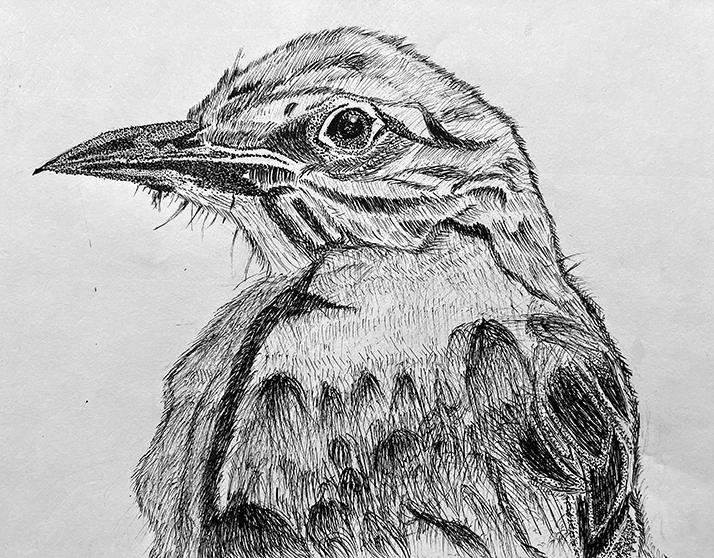
Martin Berman ’53 of Bloomfield CT, formerly of West Hartford, passed away on December 5, 2022. He was the beloved husband of Irene Levin Berman for more than 61 years. A native of Brooklyn, NY, Martin was born on February 19, 1936 to Charles and Rose (Rabinowitz) Berman. Martin spent his early life in Midwood, playing stickball with friends, drinking egg creams at the automat, and excelling in school. Well over 6’ tall by his bar mitzvah, Martin, aka “The Bear,” was a star center for the Poly basketball team and a standout Latin student. Martin attended Princeton University and Downstate Medical School. He trained in pathology at the Johns Hopkins Hospital where he was Chief Resident followed by a Fellowship at Memorial Sloan Kettering. During medical school, Martin also attended the University of London as a visiting student. While in London, Martin befriended a Norwegian student, Leif Levin, with whom he traveled through Europe. After seeing a photograph of his new Nordic friend’s sister, Irene, who he learned was living in New York perfecting her English skills, Martin knew to whom the first phone call he would make upon returning to Brooklyn. Martin and Irene married in Oslo one year later. They spent two years at Fort McPherson in Atlanta, while Martin completed his
military service, and soon thereafter settled in West Hartford, where they raised their three daughters. Martin became a staff pathologist at Hartford Hospital, later becoming Director of Anatomical Pathology. He was devoted to his work, and to teaching residents, at Hartford Hospital. Martin was blessed with many wonderful friends who shared his love of good food and wine, classical music, theater, opera, biography, Sherlock Holmes mysteries, travel, and tennis, where he was known for his killer serve. Ultimately however, it was family that gave Martin the most pleasure. Always up for a game of Scrabble or Trivial Pursuit, Martin was a constant source of astonishment to his children and grandchildren as he seemingly knew the answer to any conceivable trivia question. Martin is survived by his wife, Irene, his daughters, Carrie Beth Berman and her husband Ronald Apter of Hartford, Adrienne Berman of New York City, Rosanne Berman and her husband Daniel Wichman of Greenwich, and his adored grandchildren: Emily, Marcus, and Charlotte Apter, Jacob and David Wichman, and Amalia Berman.
Ronald Pohls ’53 passed away on January 28, 2023. Ronald always spoke of Poly Prep with great affection. More than the outstanding education, he valued the lifelong friendships he forged there most. He will be with everyone in spirit for the Class of 1953 70th reunion.
Dr. Michael Rosen ‘56 passed away on January 6, 2023 at age 84. A professor of pharmacology and pediatrics at Columbia University, Michael authored and co-authored over 500 peer-reviewed publications and received multiple national and international awards. His groundbreaking research led to the discovery that pharmacological interventions can be used to prevent and treat cardiac arrhythmias; that the heart has a memory; and, more recently, that gene and stem cell therapies might be used to create a biological pacemaker. Throughout his career, he advocated for improving public understanding of science and increasing government funding for research. A beloved teacher and mentor, Michael
OBITUARIES AS OF MARCH 8, 2023
31 POLY PREP COUNTRY DAY SCHOOL SPRING 2023
Art by Hilary Nnajiofor ’25
always took time to advise, guide, and support those who sought his counsel. Michael loved literature, music, travel, kayaking, and Cape Cod. He will be remembered for his intellect, kindness, generosity, and uncanny ability to find humor in all things. He is survived by his wife, Tove, daughter, Jennifer, and husband Rafael Valverde, daughter, Rachel, and partner Derek Morse, and granddaughters, Maya and Lily Valverde. Throughout his life, he remained devoted to the memory of his late eldest daughter, Dina, and he treasured his family and dear friends around the world.
Clifford Bernstein ’57 passed away on August 4, 2022. Cliff was born May 11, 1939. He graduated from Trinity College in 1961 and was involved in the earliest stages of information technology. He set up the first computer installations for Exxon in Brazil and Malaysia before moving back to the United States and working on computer applications. He had three children with his first wife, Marlene Roberts: Matthew, Mellisa, and Karen. He had a son, Thomas, with his second wife, Elizabeth Brunoski. He was the brother of Bruce Bernstein ‘53. Cliff was very actively involved at Poly, especially as a member of the football and track teams. He had a close group of Poly friends that he stayed connected with throughout his life including Cliff Lazaro, Anthony Goodman, and Peter Glick.
James P. Kartell M.D. ’57, a plastic surgeon, passed away on June 30, 2022. He was a 44-year Andover, MA resident who practiced in the Merrimack Valley of Massachusetts and New Hampshire for over 26 years. Dr. Kartell was born in Brooklyn and after Poly he attended the University of Pennsylvania from which he graduated with honors. He received his medical degree from The Chicago Medical School and served as president of the medical staff of Holy Family Hospital in Methuen. He had offices in Chelmsford, Andover, MA and Nashua, NH and was known for complex reconstructive and cancer surgery and elegant cosmetic procedures.
David Samuel Lifton ’57, passed away on December 6, 2022 in Las Vegas, NV. He was an engineering and physics graduate of Cornell University. David’s lifelong interest and research was the assassination of President John F. Kennedy. His book Best Evidence, published in 1981, is the story of his 15-year search for the truth about the Kennedy assassination: it was a great publication success and eventually reached #4 on The New York Times Best Seller list. At the time of his death, David was working on a sequel book about Lee Harvey Oswald. He is survived by his sister, Judith Schreiber.
Robert Walker ’59 passed away on February 9, 2023. Robert was a graduate of Brown University and Harvard Law. His brother Ed Walker, who survives him is from the Class of 1953.
1980S
Evan B. Marquit ’83 , passed away on August 9, 2022 at age 56 at his home in San Anselmo, CA. Born on November 30, 1965 in Brooklyn, NY, Evan was predeceased by his parents, Dr. Harold and Gloria Marquit. Growing up in Brooklyn, Evan attended Poly and later Dartmouth College, and was a dedicated alumnus of both. After college, he worked in New York and then, with several friends, moved to San Francisco where he discovered a deep love of the West. Fueled by his hunger for off-the-grid sporting adventure, Evan enjoyed countless mountain biking, camping, hiking, and ski trips with friends and family. He relished long drives throughout northern California, Utah, Montana, and beyond. He served as the president of the Dartmouth Outing Club of Northern California for nine years and counted Dartmouth’s Donner Summit cabin as one of his favorite places on earth. Committed to learning and teaching survival in the wilderness, he became a Sierra Club Outings leader. He pursued a career in technology, where his brilliance and thirst for knowledge were demonstrated and fulfilled. Playing
the piano with, and inspired by, his older siblings as a young boy, Evan developed his keyboard talent and became a lifelong music enthusiast. A listener as well as a player, he was at his best during jam sessions and local gigs with his many musician friends in Marin County. His eclectic taste spanned all genres and he was always ahead of the musical curve. An avid reader, Evan’s thirst for knowledge sustained him, particularly in recent years. Yet among all his talents and hobbies, perhaps his greatest gift was his many friendships, which were lifelong, rich, and highly rewarding. Evan was a devoted husband to Laura and a loving father of Sadie and Julian. Evan is survived by his brother and sister-in-law, Richard and Stacy Marquit of New York, NY; sister and brother-in-law, Andrea Marquit Clagett and Gordon Clagett of Boston, MA; nieces Amanda Marquit and Elisabeth Clagett and nephew Adam Marquit (Margot). He was thrilled with the family’s two newest arrivals, Adam and Margot’s children, Jack and Eloise.
OBITUARIES AS OF MARCH 8, 2023 32 THE BLUE & THE GRAY
Bryan Levell ’86 , passed away on November 6, 2022.
POLY STUDENTS HAVE Unrestricted Potential.

SO DOES Annual Giving
YOUR GIFT TO ANNUAL GIVING MATTERS AT POLY PREP.
Contributions of any size provide a collective stream of support that nurtures possibilities for every Poly student, today and for generations to come. Together, we can ensure Poly students have everything they need—exceptional teachers, first-rate academic programs, robust arts, athletics, and more—to reach their fullest potential.

polyprep.org/giving
THURSDAY & FRIDAY, MAY 11 & 12, 2023 7:00 PM | RICHARD PERRY THEATRE
BOOK BY
MICHAEL STEWART
CHARLES
MUSIC BY
STROUSE
LYRICS BY LEE ADAMS
MIDDLE SCHOOL MUSICAL A MUSICAL COMEDY
DYKER HEIGHTS CAMPUS 1 Poly Prep Drive Brooklyn, NY 11228



















 Eden Golomb ’26
Nate Hyman ’26
Sebastian de Luque ’23
Eden Golomb ’26
Nate Hyman ’26
Sebastian de Luque ’23
 Simone Yoskowitz ’25
Embroidery from Art & Social Change
Simone Yoskowitz ’25
Embroidery from Art & Social Change



















 3K
3
T 3A sher C ohen ’24 Adele ’23
Abb 3
Ty 3
Rohan Unis ’24
Pe ’23
Nicole Bogdanos ’23
Bennett McK ’23
Jack Levin ’24
Marie Culmine 3 Hayden Lewis 3
CLEAN TECHNOL OG Y INDUSTR Y AND COMMERCE
CLIMA TE JUSTICE HA WKS
CONVENTIONAL ENERG Y LAND , A GRICULTURE AND FORESTR Y
3K
3
T 3A sher C ohen ’24 Adele ’23
Abb 3
Ty 3
Rohan Unis ’24
Pe ’23
Nicole Bogdanos ’23
Bennett McK ’23
Jack Levin ’24
Marie Culmine 3 Hayden Lewis 3
CLEAN TECHNOL OG Y INDUSTR Y AND COMMERCE
CLIMA TE JUSTICE HA WKS
CONVENTIONAL ENERG Y LAND , A GRICULTURE AND FORESTR Y





















 ARTWORK: NOAH J.
ARTWORK: NOAH J.



















